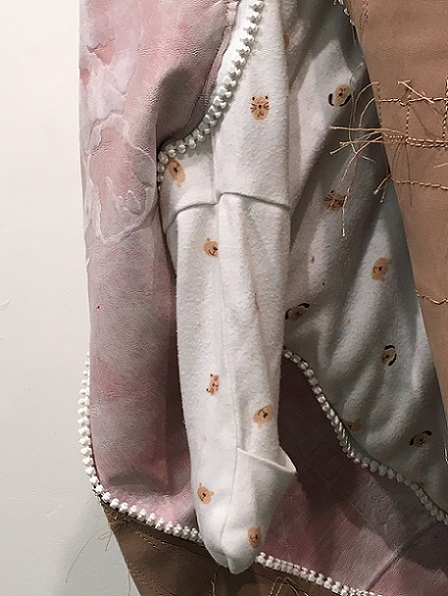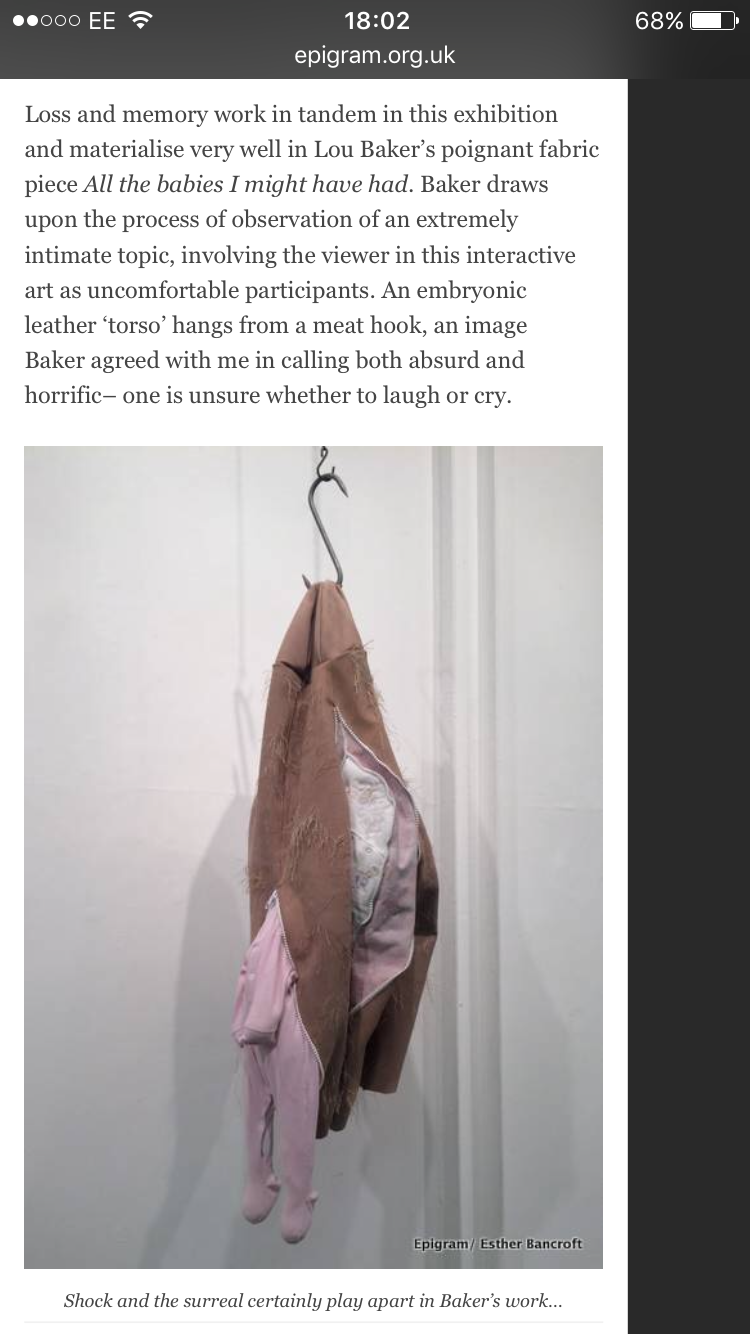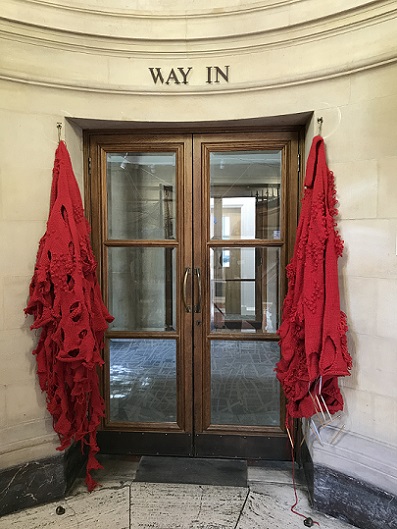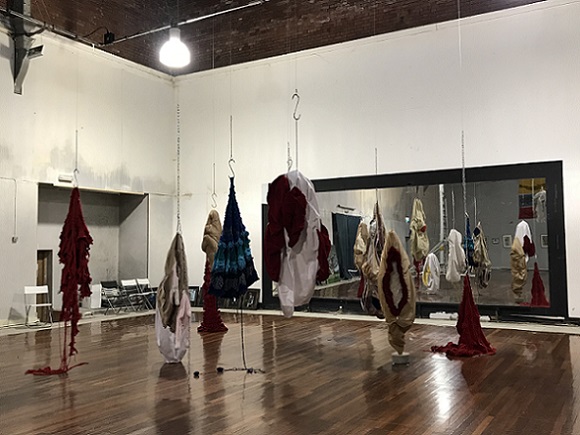* For details of my stitched work, please scroll down*
Stitch
Communication
Meaning
Provocation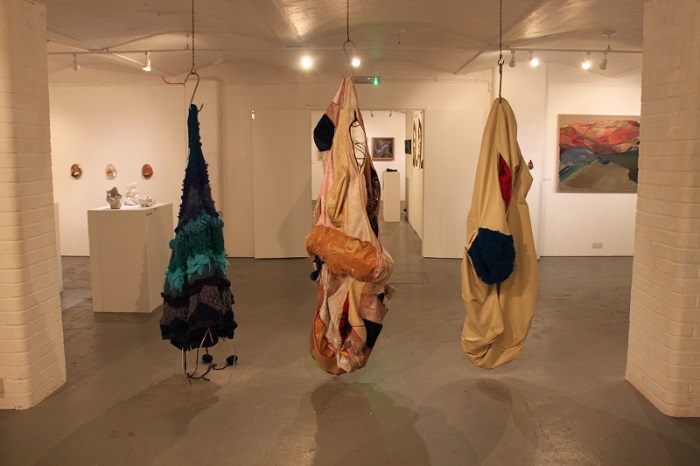
Nobodies, 2015, leather, imitation leather, used clothing, hair, knitting, felted hand knitting, paint, zips; stitch, print. Installed at Synecdoche, Embassy Tea Gallery, London, July
Subversion
The dark side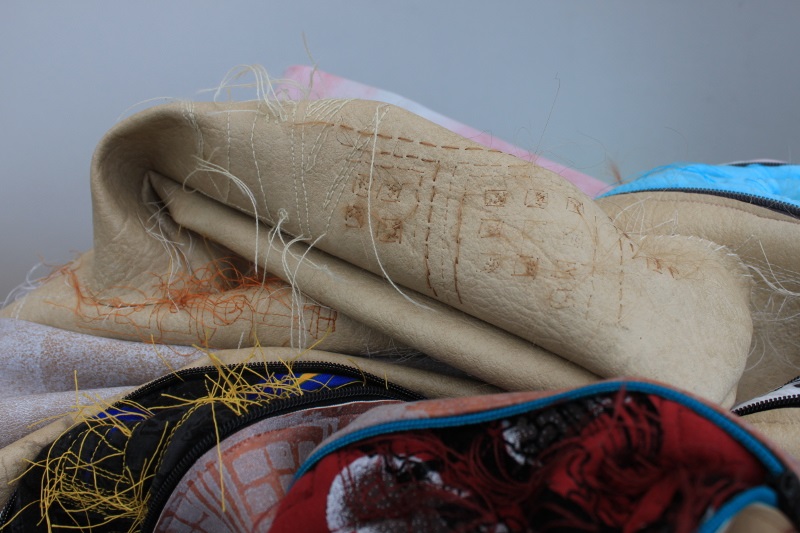
Nobody 1, 2014, detail, leather, imitation leather, used clothing, hair, paint, zips; stitch, print
Mark making
Drawing
Gestural
‘Sloppy craft’
Loose threads
All the babies I might have had II, 2015,
leather, imitation leather, used clothing, felted hand knitting, zips; stitch, print. Installed at The Knitting and Stitching Show, London, October
Line
Form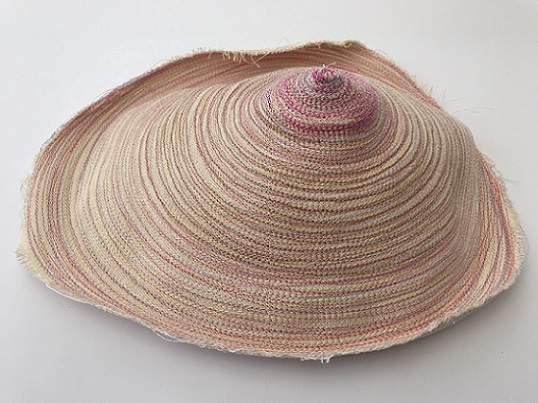
The whole is greater than the sum of the parts, 2018, detail, canvas; stitch
Colour
Surface
The whole is greater than the sum of the parts, 2018, canvas; stitch. Installed at Subversive Surfaces, Town Hall Arts, Trowbridge, June/July
Tactile
Blurring the senses
Haptic/scopic
Sculpting
The others; a self portrait, 2015, leather, imitation leather, knitting, felt, felted hand knitting, velvet, fake fur, zips; stitch. Installed at The Degree Show, UWE, Bower Ashton campus, Bristol, July
Connecting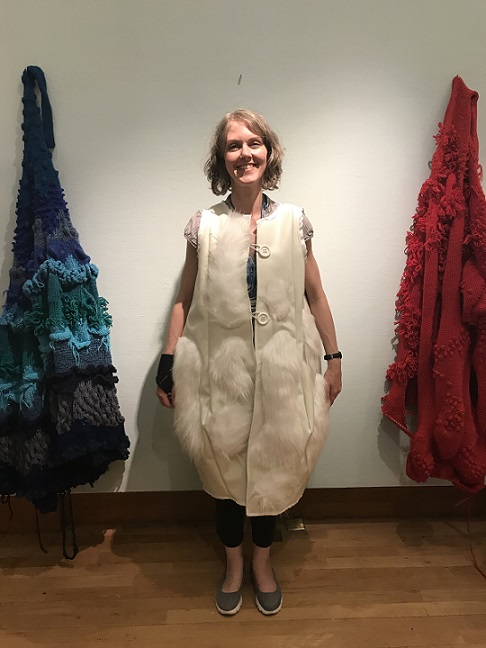
Living sculpture; white, 2018, imitation leather, fake fur, buttons. Worn by a participant at Living sculptures, Make space, Bristol Museum and Art Gallery, July
Construction
Garment making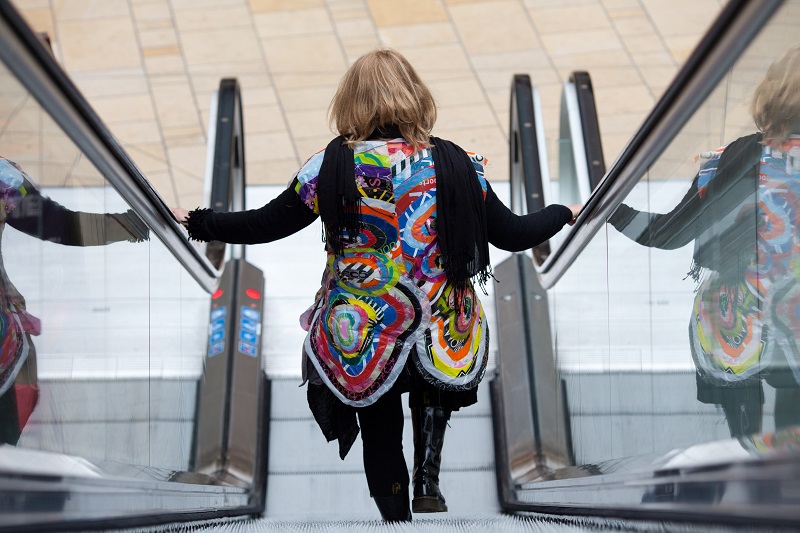
Plastic surgery, wearing the unwearable, 2012, plastic bags; stitch. Performance still, Cabot Circus, Bristol
Embroidery
Quilting
Patchwork
My imaginary friend, 2012, used clothing, velvet, zips
Drapes and folds
Hiddenness
Revealing and concealing
Layers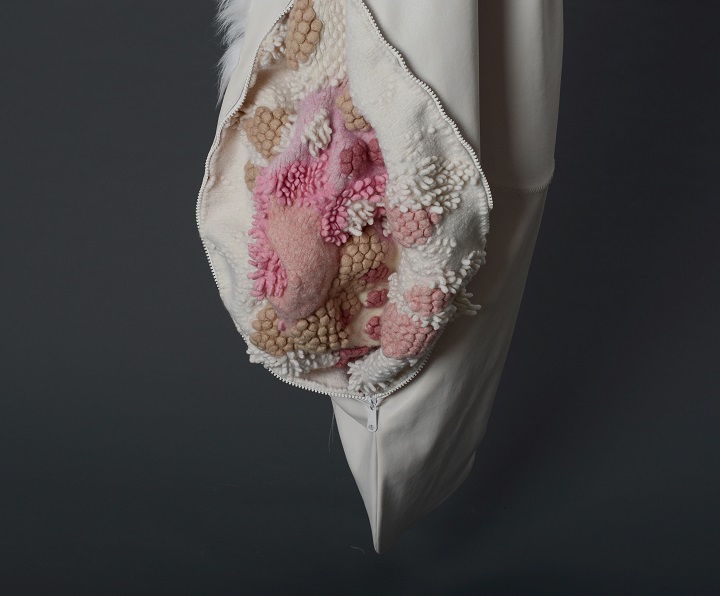
Other 1, 2015, detail, imitation leather, felted hand knitting, fake fur, zip; stitch
Thinking
Conceptual
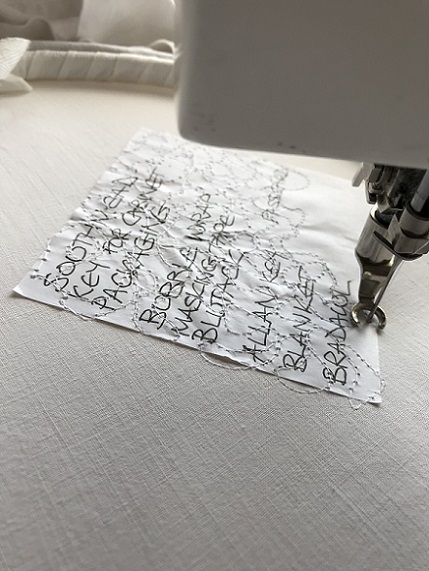
Tethering my thoughts, 2018, lists, pillowcase; stitch
Embroiderers' Guild scholar
Transformation
Alchemy
Led by materials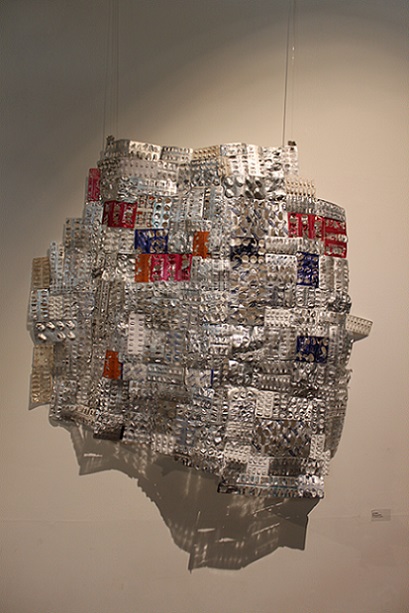
Pharmacopoeia, 2017, pill packets, staples. Installed at Subversive Surfaces, Town Hall Arts, Trowbridge, June/July 2018
Manipulation
Piercing
Tattoo
Materiality

Nobody 1, 2014, detail,leather, imitation leather, used clothing, hair, paint, zips; stitch, print
Physicality
Second skin
Therapy
Meditation
Happiness
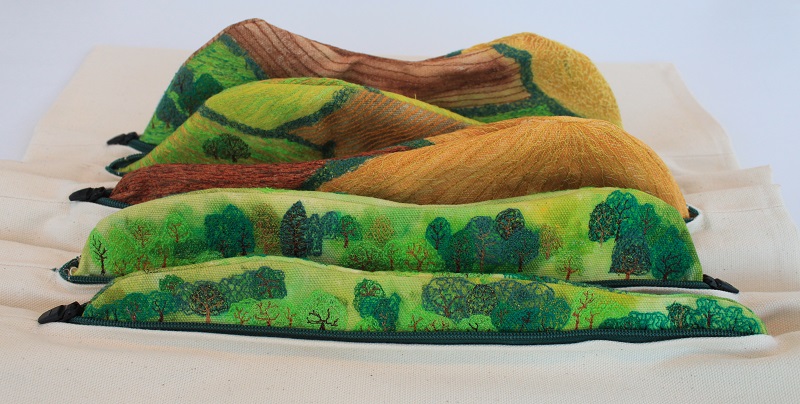
Over the hills and far away, 2012, artist's book, canvas, zips; stitch
The dark side of stitch
'Attraction and repulsion, horror and hilarity; creating an uneasy tension in aesthetics by challenging the seemingly benign nature of traditional textile processes, Lou Baker’s life-sized soft sculptures provoke a range of conflicting responses. Using cloth and stitch as a vehicle for meaning, her investigations into the transformation of materials and the sculptural and mark-making potential of stitch subvert conventional representations of the body, forging intellectual connections between material, process and concept. 
All the babies I might have had II, 2015, detail,
leather, hand knitted felt, used baby clothes, zips; stitch, print
Visually pleasing with an uncanny bodily presence, these troubling forms explore individuation, a process which, according to Carl Jung, needs to occur in the second half of life, of finding meaning in life. It is ultimately a preparation for death. Jung talks about balancing our multiple selves with the dark side, or shadow, of ourselves and maintains that failure to acknowledge and accept this shadow can result in fragmentation and associated mental health issues. He also describes the shadow as being the seat of creativity, and creativity is linked to happiness. 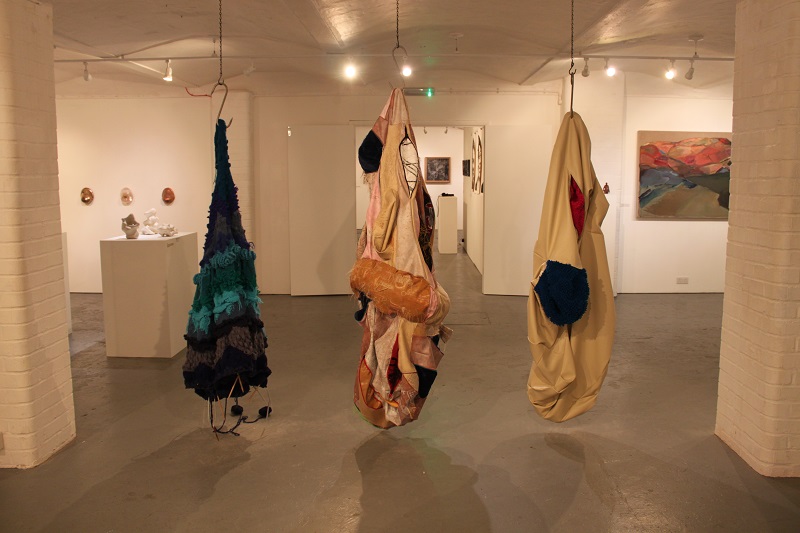
Nobodies, 2014, installed at Synecdoche, Embassy Tea Gallery, London, June, hand knitted wool, imitation leather, leather, velvet, used clothing, hair, hand knitted felt; stitch, print
Baker regards her work as a form of self-portrait, a reflective and emotive response to the ongoing excavations of her dark side, an embodiment of a mid-life crisis, with an undercurrent of dark humour. The change in control brought about by processes of alchemy underpins her investigations into the dialogue between personal memories and universal themes. She makes public things that are normally private.
For her, making is meditation; many of the techniques she uses are labour intensive and repetitive, inducing a state of meditative timelessness which creates a profound sense of well-being. The psychologist, Mihaly Csikszentmihalyi, calls this the state of flow, which, he maintains, is also linked to happiness.
Baker’s work interrogates the stereotypical, gendered expectations of work with textiles in many ways. Cloth itself is regarded as a gendered material; Roszika Parker, in her book, The Subversive Stitch, analyses the gender divide between ‘high’ art and feminised craft and proposes that cloth is a signifier of the private, and thus feminine, sphere. The critical theorists, Julia Kristeva and Mary Douglas, suggest that there are also femininities associated with discarded clothing, hair and recycled imitation leather linked to dirt, contamination anxiety and the abject which add meaning to Baker’s choice of materials.
Cloth as an unconventional medium in sculpture also adds to the meaning it conveys. Traditionally, hard, durable materials like stone, marble and bronze have been used; the soft, impermanent nature of cloth, however, evokes the human form and its mortality. 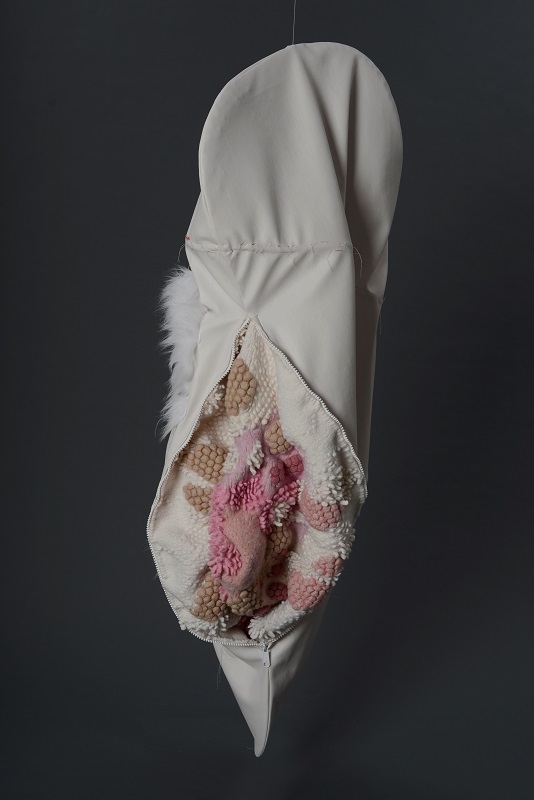
Other 4, 2015, detail, imitation leather, fake fur, zip; stitch
There is a merging of the senses of touch and sight associated with cloth as well. Using a range of traditional textile processes, Baker creates poignant skin-like surfaces which blur the visual/tactile divide. Cloth can also be regarded as an extension of the body, a second skin.
Nobody I, 2014, detail, imitation leather, leather, velvet, hair, used clothing; stitch, print
As a former Embroiderers’ Guild Scholar, a high level of skill in her work is important to her, as is the rich tradition of embroidered textiles. However, at times, she feels that her stitched work needs to be ‘sloppy craft’, rougher, gestural and emotive, in order to communicate a range of alternative meanings and leave clear evidence of her making. Blurring the boundaries between craft and fine art, her work excavates the possibilities of there being a dark side to the perceived notions of knitting and embroidery as gendered, decorative, safe, clean, perfect and private pursuits.'
For further reflections on stitch read my blog posts The dark side of stitch, Cloth and the abject, Giant genitalia; in defence of the zip and my Embroiderers' Guild Scholar's report.
For more images and details of my stitched work, please scroll down.
Gallery of stitched work:
1. All the babies I might have had II, 2015, leather, baby grows, zips; stitch, print
2. Displacement activity #9: Sculpting with pill packets and a stapler, September 2017
3. The Others; a self portrait, 2015, installed at The Degree Show, UWE, June
4. Nobodies, 2014, installed at Synecdoche, Embassy Tea Gallery, London, July 2014
5. Nobody 1, 2014, imitation leather, leather, velvet, used clothing, zips, hair, acrylic paint; stitch, print; 190 x 70 x 70 cm, 5.5kg approx., floor installation
6. Nobody 1, detail
7. Nobody 1, detail
8. Nobody 1, detail
9. Nobody 2, 2014, detail, hand knitted felt, zips; stitch; 175 x 40 x 60cm
10. Cosy series, triptych, 2014, cloth, stitch
11. Seascape, 2010, detail, stitch on canvas
12.My imaginary friend, 2010, installation, used clothing, zips;stitch
13. No animals have been harmed in the making of this garment, 2011, fake fur, cuddly toys; stitch, 150 x 100 x 60cm
14. The parts I'd like to remove, 2010, canvas, fabric samples, maps, anatomy textbook pages, zip; stitch
15. False memory # 1, 2014, velvet, beanie bottom; stitch
16. Beanie baby, 2012, side view, baby grow; stitch
17. Articulated hand, 2012, canvas; stitch
18. Horizon, 2011, acrylic and stitch on paper, reversed, installation view
19. Over the hills and far away, 2011, artist's book, canvas, acrylic, zips, ribbon; stitch
20. Plastic surgery, 2012, plastic bags, stitch, performance still
21. Pod of wonder, 2014, detail, imitation leather, velvet, quilted and stitched drawing, zips
22. Seascape triptych, 2012, detail, acrylic and stitch on canvas
23. Tethering my thoughts, 2018, work in progress, lists, pillowcase, stitch
July 2018, Living sculpture (white & furry), imitation leather, fake fur, buttons
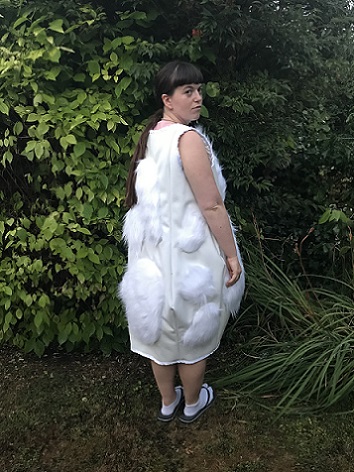
I have had the idea of making a selection of garment-like, wearable soft sculptures for a while now. I wanted to offer visitors the opportunity to become active participants by inviting them to not only touch, but to wear these sculptures. In 2018 I had a proposal to this effect accepted. I set up Living sculptures, a participatory installation, for one day in July at Bristol Museum and Art Gallery’s Make Space, a room alongside The Woman’s Hour Crafts Prize exhibition.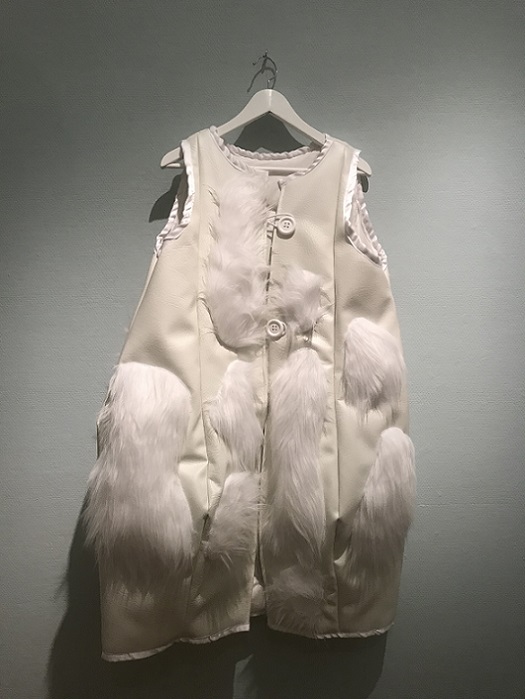
Identity is often communicated through the clothes we wear, but, at a deeper level, the multiple selves we reveal to the world can conceal our true sense of self. Living sculptures investigates this disconnect. For more details of this event please have a look at my Exhibitions page and for details of the interactive aspects have a look at my Participatory art and social engagement page.
One of the sculptures I made for that event was Living sculpture (white & furry). It’s made out of white imitation leather and has sculptural, stuffed patches of fake fur stitched to it. Because of the rigidity of the imitation leather, it has a quirky bell-like shape. I added 2 large white buttons as closures.
It’s probably the most easily wearable Living sculpture so far. It almost looks as if it could be an actual article of clothing, albeit rather an eccentric one! I think, for this reason, I like it least! It’s not weird enough. However, it’s only had one day’s outing so far, and maybe, as one of a multitude of wearable sculptures it would work better. Maybe though, for some people it would be easier to try on as it’s not so odd!
I did enjoy the way that it made people move in interesting ways, though! One of my models was compelled to strike a range of classic modelling poses.....
....whilst participants at Make Space posed, danced and rocked!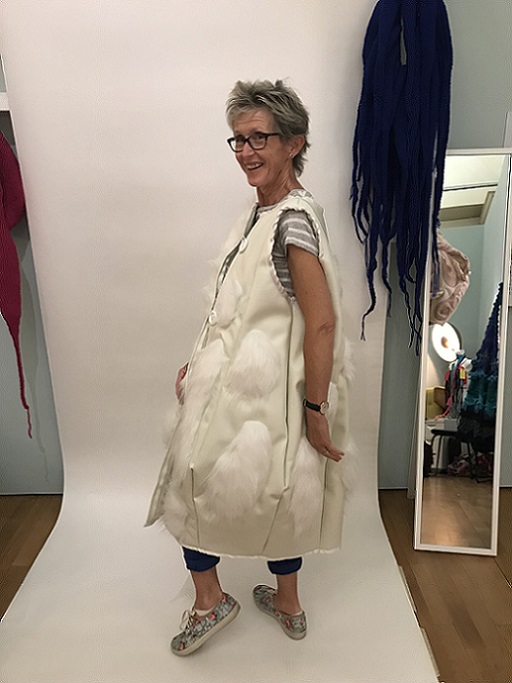
It was an interesting challenge to make sculptures that could be put on and worn by anyone and everyone, in terms of age, size and ability. I haven’t yet had the chance to see how a child would cope, but I hope to find out at some point.
Have a look at the full documentation of the research I have done with my Living sculptures, by clicking on the image below. It includes a week trialing Living sculptures at disquiet, Walcot Chapel, Bath in September 2018. Living sculpture, white & furry didn’t feature during that week, but my knitted Living sculptures did!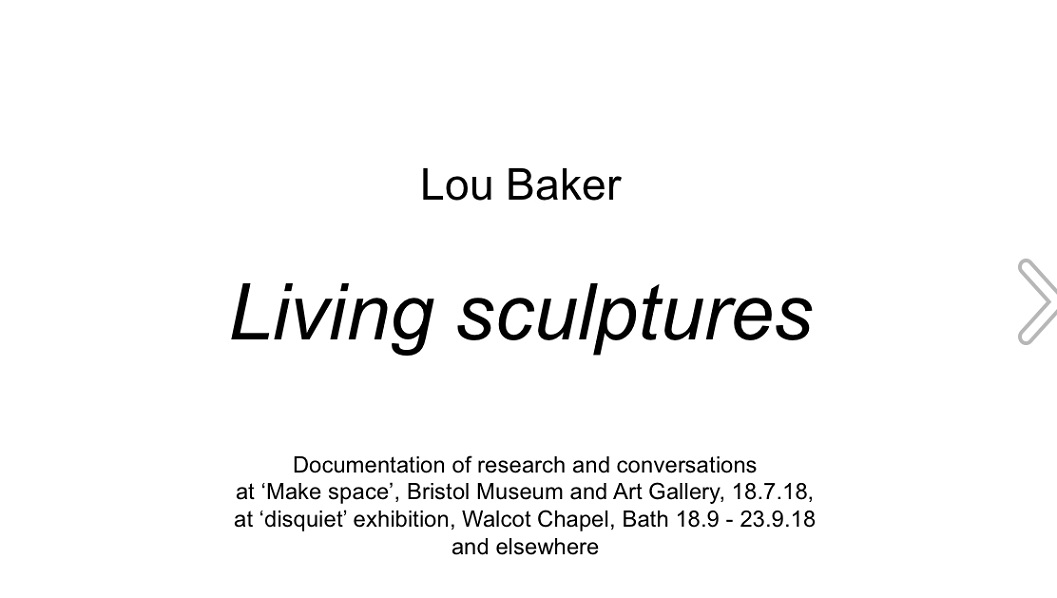
And here are some more images:
May 2018, The whole is greater than the sum of the parts, canvas, intensive stitching

The whole is greater than the sum of the parts is a hanging, stitched soft sculpture. Constructed as a quilted patchwork of abstract body parts, intensely embroidered with a selection of skin coloured threads, it’s a form of self-portrait, a reflective and emotive response to the ongoing excavations of my dark side, an embodiment of a mid-life crisis, with an undercurrent of dark humour. It makes public things that are normally private and, as with much of my work, it provokes a range of conflicting responses.
It is an exploration of individuation, a process which, according to Carl Jung, needs to occur in the second half of life, of finding meaning in life. It is ultimately a preparation for death. Jung talks about balancing our multiple selves with the dark side, or shadow, of ourselves and maintains that failure to acknowledge and accept this shadow can result in fragmentation and associated mental health issues. He also describes the shadow as being the seat of creativity.
For me, making is meditation, a form of therapy; many of the techniques I use are labour intensive and repetitive, inducing a state of meditative timelessness which creates a profound sense of well-being. The psychologist, Mihaly Csikszentmihalyi, calls this the state of flow, which, he maintains, is also linked to happiness. The change in control brought about by the repetitive stitching as it sculpts the canvas is a form of alchemy.
1,2. The whole is greater than the sum of the parts, installed at Subversive Surfaces exhibition with Gina Baum at Town Hall Arts, Trowbridge
3-5,7-12. Details of abstract body parts as works in progress
6. Sculpting with intensive machine stitching on canvas
13. Construction of the sculpture
14. Me wearing the partly made sculpture!
15. A friend wearing the sculpture at the Subversive Surfaces exhibition
Work in progress
2018, Tethering my thoughts, lists, pillowcase; stitch
Louise Bourgeois said that she used drawing as a way of tethering her thoughts.
I am a compulsive writer of lists; I make a list at least once a day and often have more than one list. For some reason I've been collecting them and have just begun to stitch them to an old pillow case. I often wake in the middle of the night with a hyperactive mind and find it hard to get back to sleep and the things on my lists are often the subject of these hours of insomnia. I think of free machine embroidery as a form of drawing and a way of possibly tethering those thoughts, but I'm also conscious that once again I'm making public things that are normally private. Interestingly, my issues with listomania and insomnia seem to resonate with many.
Tethering my thoughts, 2018; it begins!
Have a look at a video of me tethering my thoughts using free machine embroidery.
Free machine embroidery is yet another activity which, for me, quickly induces that profound meditative timelessness, Csikszentmihalyi's state of flow. It's closely linked to creativity and ultimately to happiness. It's repetitive, calming and also frees my mind to think in a different way.
Work in progress
Stitching paper has been an interesting experiment, as it inevitably tears in places. It's hard to stitch certain parts of the pillow case with the machine, so I might use hand stitch for some areas, or maybe staples? Or pins or safety pins?? I see all of these as forms of stitch, and I quite like the idea that the whole pillowcase would be very uncomfortable to sleep on once I've finished with it! I am also leaving my trademark loose ends at strategic points as I stitch. A hint of unravelling?
The back of the stitched drawing is different again, translucent, with variable intensity, with some of the writing faintly visible.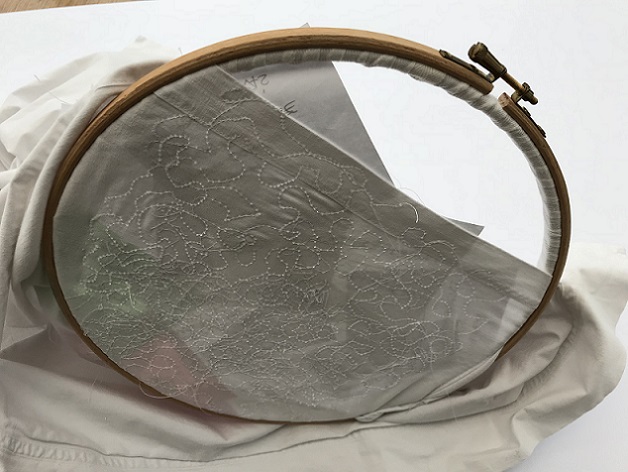
Translucent stitches....
This is a work in progress, so I'm not sure how it will develop. I like being led by the materials. I'm wondering about possibly hanging it, painting it with latex, putting a pillow back inside it.....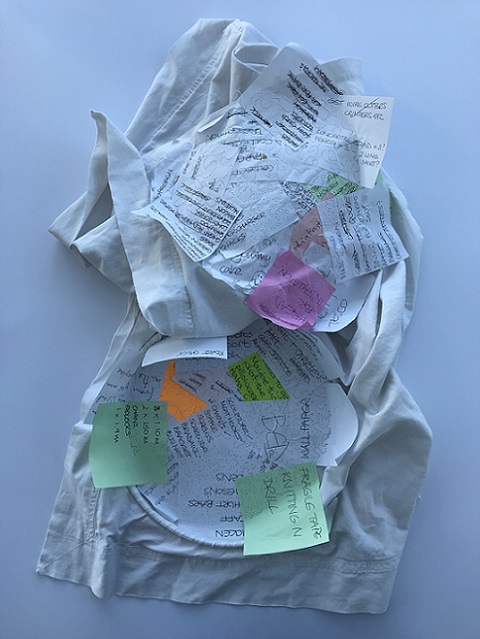
25.1.18
And here are some more images of me tethering my thoughts:
1. Lists galore.
2. It begins! Mesmerising stream of consciousness drawing with stitch, 19.1.18
3. First embroidery hoop of stitching, 19.1.18
4. Reverse of the stitching, inside the pillowcase. Light shines through the pierced cloth and there is a faint trace of the writing showing through, 21.1.18
5. Reverse of the stitching with intentional marks made by loose ends, 21.1.18
6. It continues! 21.1.18
7. 25.1.18
8. Work space, 1.2.18
2017, Pharmacopoeia aka Displacement activity #9: sculpting with pill packets and a stapler

Renamed! Pharmacopoeia, installed at Subversive surfaces exhibition at Town Hall Arts, Trowbridge, May- June 2018
I have been collecting empty pill packets for a while. I’m interested in them for several reasons. I have to regularly take tablets myself so I gather a few a month; if I’m unwell, of course, the pile grows. I have also discovered, through this strange collecting obsession, that a number of dear friends have to take many tablets every day to stay well. It is subsequently very poignant when I receive their latest stash, a bag or bundle of pill packets. I find the actual packets visually interesting, they are the same but different. They change form when the pills are popped out of them, curving as the surface tension changes, already becoming sculptural. It also interests me that I can elevate something that would normally be discarded by incorporating it into art. The ultimate in recycling? I also really like their associations with bodies.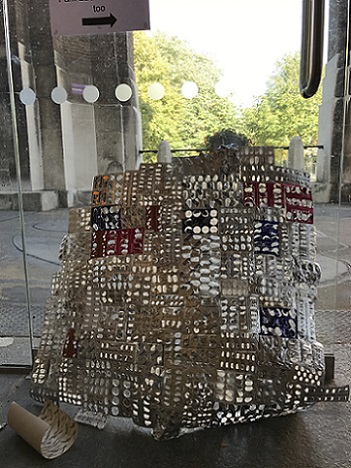
Displacement activity #9: sculpting with pill packets and a stapler
I love the way the light shines through the empty spaces.
In September 2017 I took part in a month-long residency with Synecdoche, [dis]place at The Vestibules in Bristol. Unfortunately, for the previous 6 weeks I had been manically knitting for a deadline and had damaged my wrist, so I couldn’t knit for a while. I was bereft! Instead I embarked on a series of site responsive research projects which I called Displacement activity. Have a look at my Installation and site responsive works for more details.
Sculpting with pill packets and a stapler was Displacement activity #9. I needed to do things that could be easily interrupted as I often had to stop what I was doing to talk to visitors or other artists or sort things out so I took my collection of pill packets…. and a stapler! I started hand stitching the packets together with red thread but soon realised it wasn’t immediate enough so I started stapling them together instead.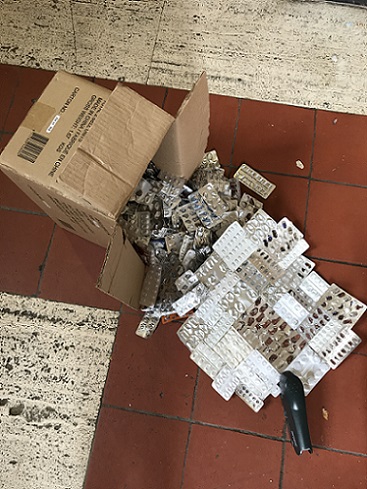
It begins! Day 10 of Synecdoche's [dis]place residency, 18.9.17
I love the idea of a staple being a stitch. I like the gestural nature of stapling, although it was trickier than I originally thought. It’s very cathartic - rhythmic, repetitive and definitely fits my state of flow criteria so meditative too! The process of stapling was like the narrative of someone’s ill health or pain. It feels precarious, like ineffectual mending. It’s like making a patchwork; the whole is greater than the sum of the parts. It becomes something ‘other’. It’s alchemy; the pill packets are transformed through a mundane process. I am making public things that are normally private.
For a snapshot of me stapling pill packets (and the residency generally), have a look at [dis]place finissage 2017, a video by Francis Martin.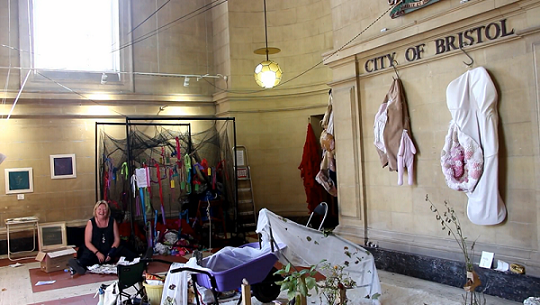
A still of me stapling pill packets from Frances Martin's video [dis]place finissage
I also found it was a talking point for visitors; I had some poignant conversations about dependence on medication and ill health. They are a provocative material – many people were attracted to the finished piece because it sparkled and then were shocked or delighted when they saw what it was made from.
Here are some of the things that people said about it:
‘That’s my life. Right there.’
‘It looks like something else and then you get close and recognise what it’s made of.’
‘Oh! Thanks for reminding me. I need to take my tablet.’
‘It’s like a dalek…. Or a suit of armour.’
‘It makes me think of armour, protection. You could make a jacket.’
It was also a wonderful environment to experiment with hanging and photographing the sculpture that I made. 
Displacement activity #9: Sculpting with pill packets and a stapler
installed at Synecdoche's [dis]place at The Vestibules, Bristol, Day 14, 22.9.17
It’s hard to see this piece as finished, but maybe it is, maybe it isn’t. I still have a growing collection of pill packets and plan to do more with them so time will tell….
Have a look at this gallery of images:
1. A parcel of pill packets from a friend arrives in the post.
2.- 6,. It begins. 18 & 19.9.17
7. & 12. Both sides.
8, 9, 13 - 16, 18 - 29. Trialling different installations
10, 11, 17. The light shines through…
30. A still of me stapling pill packets from Frances Martin’s [dis]place finissage video, September 2017
31,32. Installed as Pharmacopoeia at Subversive surfaces exhibition at Town Hall Arts, Trowbridge, May-June 2018
2015, All the babies I might have had II
1. All the babies I might have had II and Nobody 1, installed at The Knitting and Stitching Show, London, October 2015
2-5. All the babies I might have had II, detail, leather, used clothing, zips; stitch
6. All the babies I might have had II, detail, leather, used clothing, zips; stitch, H106 x W65 x D60cm (Suspended with meat hook and chain)
‘Textiles command an intimate relationship with the body. Our earliest known examples of dress used the skin of animals to cover the skin of people. Critic Anne Hamlyn refers to the textiles we wear as a ‘surrogate skin, a body at one remove’ (Hamlyn, 2000, p42).
As part of my Embroiderers’ Guild Scholarship I have been exploring further the sculptural capabilities of leather and stitch to provoke an abject response. Leather is obviously the closest material to human skin that I can legally use; it is skin! Skin is the boundary between self and other. For All the babies I might have had II I have used a tan nubuck leather hide, which is suede-like and has an interesting rigidity. I have stitched quilted and partly stuffed baby grows, with beanie sections, into the zipped openings.
All the babies I might have had II, detail,
installed at The Knitting and Stitching Show, London, October 2015
I have used baby grows in my work in the past and I know that they are highly emotive; using them to create a piece of work to exhibit at The Knitting and Stitching Shows where the audience is predominantly women of a certain age was a very conscious decision. I want my work to provoke a response and I know that, possibly for women in particular, there are many stories of sorrow around childbirth. This work is based on my own story, but I know it will have a universal resonance.
All the babies I might have had II, detail,
installed at Privy at The Edwardian Cloakrom, Bristol, June 2016
I found my response to working with baby grows intriguing. I couldn’t even consider using the few of my son’s baby clothes that I have kept, so these are anonymous, bought from a charity shop. Does this matter? I feel that it actually adds meaning as these represent an accumulation of all the anonymous babies that have not been born.
Is it too literal? Possibly. But I thoroughly enjoyed the freedom of doing what I felt like doing without the constraints of how my University tutors would respond and without having to justify it. I find a dark humour in cutting up baby grows too. They are obviously not babies, but their presence strongly suggests babies. It reminds me of what Bernadac says of Louise Bourgeois’ use of clothing:
‘A garment is …like a stuffed animal, it is a transitional object that represents a person, suggests a mood or evokes an emotional experience’. (Bernadac, 2004, p 155)
And I have stitched and stuffed them so that they are very baby-like, including beanie sections to give weight and form to the limbs…. 
Attraction or repulsion? A couple of viewers can't resist touching
All the babies I might have had II at Memory of Space, November 2016
Investigating the notion of stitch as tattoo, I have used a range of flesh coloured threads to draw onto the leather using free machine embroidery. The drawings were abstractions from the original photo cut-outs I used for Nobody I, memories of what is left behind when someone leaves. This time, however, I stitched drawings onto every surface, ‘tattooing’ my memories into the leather, and partly concealing them with loose threads, creating a troubling, hairy surface which blurs the boundaries of visual and tactile experience (Bristow 2011: 45).
‘…hair and skin are sometimes treated as culturally and biologically synonymous, while at the same time, paradoxically, hair is treated as other, different, abject, outside the body’ (Tondeur, 2012)
Leaving hanging threads is becoming a recognisable and important part of my work; I consider the loose threads to be a deliberate form of mark making. Their seemingly random placing is an illusion. In this piece, the colour is selected to blend with the colour of the leather so that the stitching becomes almost invisible. The ends are carefully kept from being stitched into, cut to a particular length, and placed at chosen points in the stitching. Sometimes I have added extra loose ends by stopping, cutting, then continuing stitching. Some threads are curled from being wound on the reel which adds an extra dimension of fluidity to the work.
All the babies I might have had II, detail,
installed at The Memory of Space, Centrespace Gallery, Bristol, November 2016
I have fabricated a surface which amplifies ways for the eyes to ‘feel’ the hairiness. There is a merging of the senses of touch and sight associated with cloth; ‘The eye…does not simply look. It also feels. Its response is both visual and tactile…’ the senses are ‘…each enfolded in the other’ (Barnett 1999: 185). This means that cloth can also be regarded as an extension of the body, a second skin. I suggest that the materiality and skin-like nature of cloth provides an alternative range of meanings, operating ‘both through the haptic and the scopic simultaneously, the two modes of perception provide differing points of access to the viewer’ (Dormor 2008: 240). 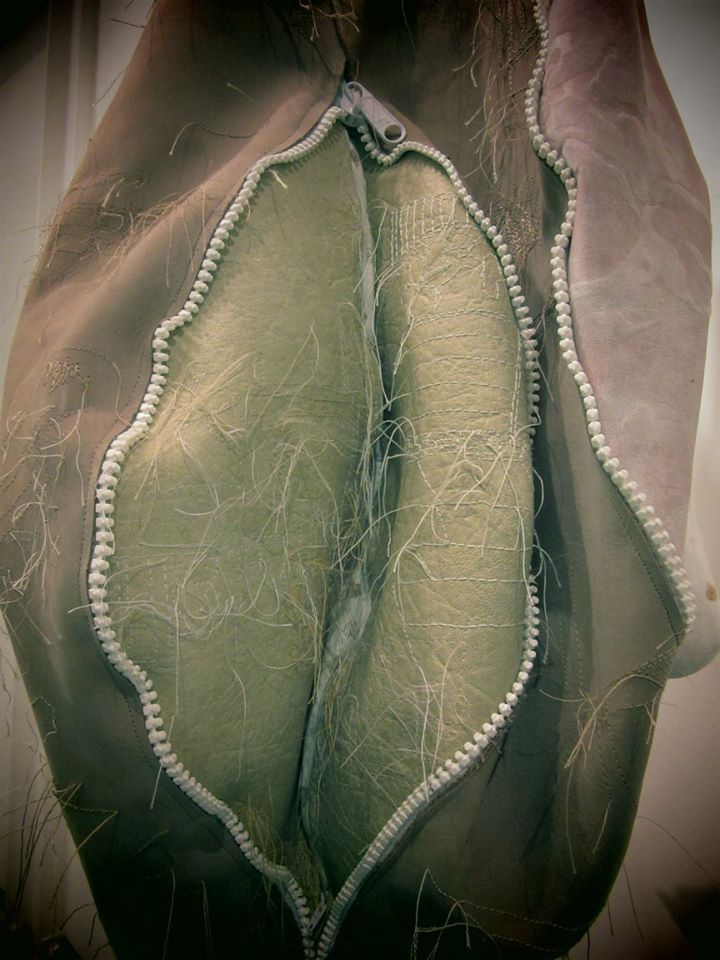
All the babies I might have had II, detail,
installed at Memory of Space at Centrespace Gallery, Bristol, November 2016
I am very conscious of the multiple piercings of the leather as I stitch…and the multiple piercings of my fingers as I work with such a difficult material! As each stitch pierces the leather it echoes the pain of absence, but is also therapeutic, as through the pain comes creativity.
Have a look at the article Memory, the self and the conflicts of modernity by Esther Bancroft on the Epigram website. She critiques this piece as part of a review of the Memory of Space exhibition which took place at Centrespace Gallery, Bristol in November 2016. Unfortunately the images have now disappeared.
Part of Epigram's review of The Memory of Space exhibition
at Centrespace Gallery, Bristol
Look at All the babies I might have had I as well. It's a hand knitted, felted web which is suspended using tension and gravity. It's visually very different to this sculpture but deals with the same theme. I have also written about it in my blog post, All the babies I might have had?
All the babies I might have had I,
installed at Pattern, Fringe Arts Bath, May-June 2016
Select bibliography
Barnett, Pennina, 1999, ‘Folds, fragments and surfaces: towards a poetics of cloth’ in Hemmings, Jessica (ed.), 2012, The Textile Reader, Berg: London, New York pp 182 -190
Bernadac, Marie-Laure, 2004, Louise Bourgeois. Paris, Musée D’art contemporain de Bordeaux
Bristow, Maxine, 2011, ‘Continuity of touch- textile as silent witness’ in Hemmings, Jessica (ed.), 2012, The Textile Reader, Berg: London, New York pp 44 – 51
Dormor, Catherine, 2008, ‘skin: textile: film’ in Textile, Volume 6, Issue 3, pp 238-253
Hamlyn, Anne, 2000, ‘Textures of Memory’, n.paradoxa 6 pp40-43 in Hemmings, Jessica, 2008, ‘Grown fashion: animal, vegetable or plastic’ in Textile, Volume 6, Issue 3, pp262 -273
Prasarn, Numidas, 2012, The Evolution of Fashion as a Signifier, Available from: http://coilhouse.net/2012/11/the-evolution-of-fashion-as-a-signifier/ [Accessed 9 November 2013]
Tondeur, Louise, 2012, ‘Patrolling of the Cultural Borders of the Body: Is Hair a Second Skin?’ in Textile: The Journal of Cloth and Culture, 1 January 2012, vol. 10, no. 3, pp. 262-275(14), [Accessed 30 September 2013]
2015, The Others: a self portrait
1 - 7 Other 1, 2015, imitation leather, hand knitted felt, fake fur, zip; stitch, H137 x W55 x D55cm (Suspended with steel wire)
8 - 12 Other 2, 2015, imitation leather, velvet, zips; stitch, H125 x W65 x D65cm (Suspended with steel wire)
13 -16 Other 3, 2015, imitation leather, felt, zips; stitch, print, H130 x W60 x D60cm (Free standing; hidden stand, concrete base, metal pole)
17-23 Other 4, leather, velvet, knitting, zip;stitch, print, H190 x W65 x D55cm (Free standing; visible concrete base, hidden metal pole)
24 -29 Other 5, leather, knitting,zips; stitch, H137 x W55 x D60cm (Suspended with steel wire)
The Others is a compelling series of 5 soft sculptures which has developed into a form of self-portrait, a reflective and emotive response to the ongoing excavations of my dark side. I have continued to use cloth and stitch to explore notions of loss and the abject. Using soft, impermanent, skin-like textiles in sculpture, with their associations with craft and the feminine, powerfully subverts traditional representations of the body and evokes its mortality, revealing alternative meanings in its folds and surfaces.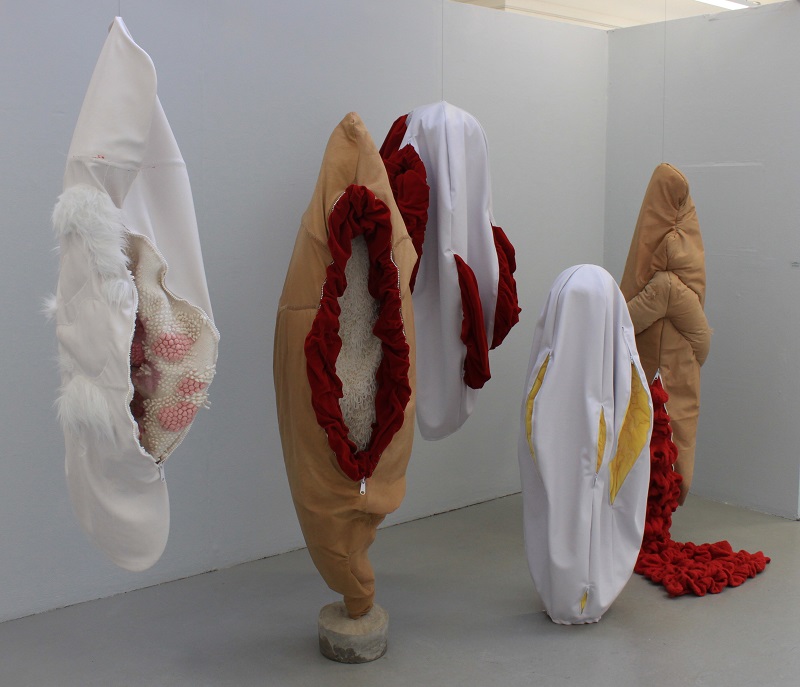
The others; a self portrait, 2015, installed at The Degree Show, UWE, June
Individually, the sculptures are aesthetically pleasing yet troubling; as a series they are imposing, an uncanny bodily presence. I feel that I have successfully produced a disturbing tension between repulsion and attraction through the materials and processes I have chosen and by the careful consideration of similarities and contrasts in form, colour and complex surfaces. This creates a disturbing synthesis between visual and tactile experience.
Other 1, 2015, detail,
imitation leather, fake fur, hand knitted felt, zip; stitch
The focus of this body of work is on individuation, a process which, according to Carl Jung, needs to occur in the second half of life, of finding meaning in life. It is ultimately a preparation for death. Jung talks about balancing our multiple selves with the dark side, or shadow, of ourselves and maintains that failure to acknowledge and accept this shadow can result in fragmentation and associated mental health issues. He also describes the shadow as being the seat of creativity.
Although The Others are included here on my Stitch page, many of them also, obviously feature sculptural knitted sections. Have a look at my Knitting page and my blog post I knit therefore I am for more thoughts about knitting. 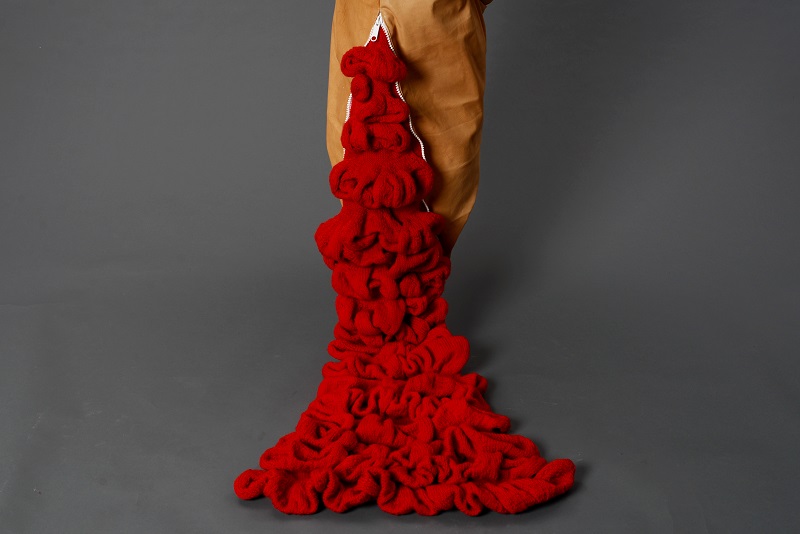
Other 5, 2015, detail, leather, hand knitting, zip; stitch
'They can be whatever you want them to be'. I like to think there is also a playful aspect to my work. That many people see genitalia is one; sculpting my aging body as an assortment of oddly quilted, saggy body bags is another! 
Other 4, 2015,
leather, velvet, hand knitting, concrete, zip
Read more reflections on my use of zips in my blog post, Giant genitalia; in defence of the zip, one year on.
Other 3, 2015, detail, imitation leather, velvet, zips; stitch
Choosing to hang several of the sculptures has increased the sense of the abject and added a spectral quality; considerations of scale, height of hanging and proximity amplify the immersive nature. That the hanging sculptures move randomly without the need for animatronics is a bonus! Ideally, I would like to install a multitude of them in a confined space so that the viewer has to walk amongst them; adding an element of claustrophobia would, I believe, offer a highly disturbing experience in a surreal landscape.
NOTE: In December 2017 I did just this! I installed 11 of my soft sculptures at PRILIC exhibition in a semi derelict swimming pool, Jacobs Wells Baths, in Bristol. It has been a Dance Centre so there is also a wall of mirrors... my soft sculptures became a Multitude!
Read my blog post Cloth and the abject and my Embroiderers' Guild Scholar's report for more thoughts about this work.
I have also worn these sculptures as part of my Wearing the unwearable series. Have a look at my Performance page for more images and details.
Other 5, Wearing the unwearable, 2015
I used my Embroiderers' Guild Scholarship Award to buy the leather for Other 4 and Other 5.
2014, Nobodies
1. & 2. Nobodies, 2014, installed at Synecdoche, Embassy Tea Gallery, London, July 2014
3. & 9. Nobody 1, 2014, imitation leather, leather, velvet, used clothing, zips, hair, acrylic paint, stitch, print; H190 x W70 x D70 cm, 5.5kg approx
4.,5.,6.,& 8. Nobody 1, detail
7. Nobody 1, floor installation
10. Nobody 2, 2014, detail, hand knitted felt, zips, stitch; H175 x W40 x D60cm, 2.9kg approx
11. Nobody 3, 2014, detail, hand knitted wool, knitting needles, H200 (including hanging knitting needles and yarn) x W55 x D55cm, 3.2 kg approx
Nobodies is a series of three soft sculptures, hanging from meat hooks and chains, which explore ways that cloth and stitch can evoke the abject in art. The critical theorist, Julia Kristeva, describes the abject as the instinctive feeling of horror ‘to a threatened breakdown in meaning caused by the loss of the distinction between self and other’. It is that which inherently disturbs conventional identity and cultural concepts. I have researched the ways Christian Boltanski and Louise Bourgeois use empty second-hand clothing in their work to suggest a physical absence and ultimately, death, the most extreme abjection. Choosing to use cloth in sculpture can powerfully subvert traditional representations of the body.
Using a series of photo cut-outs from a photo montage book I made my son for his 18th birthday, the idea of ‘body, no body, nobody’ was born. Each photo has a distinctive cut-out shape, framed with a memory of a place or time. For this project I am examining my responses to my only child leaving home and the impact that has had on my life. I have been exploring ways to communicate the mixture of emotions involved in this transition, in terms of identity and purpose, loss and absence, through the visual language of abjection. What is left behind when someone leaves? Although it describes a personal journey, it will inevitably resonate with others.
It was on the strength of Nobody 1 that I was awarded The Embroiderers' Guild Scholarship for 2015-16. Read more about it in my blog post Cloth and the abject and my Embroiderers' Guild Scholar's report. 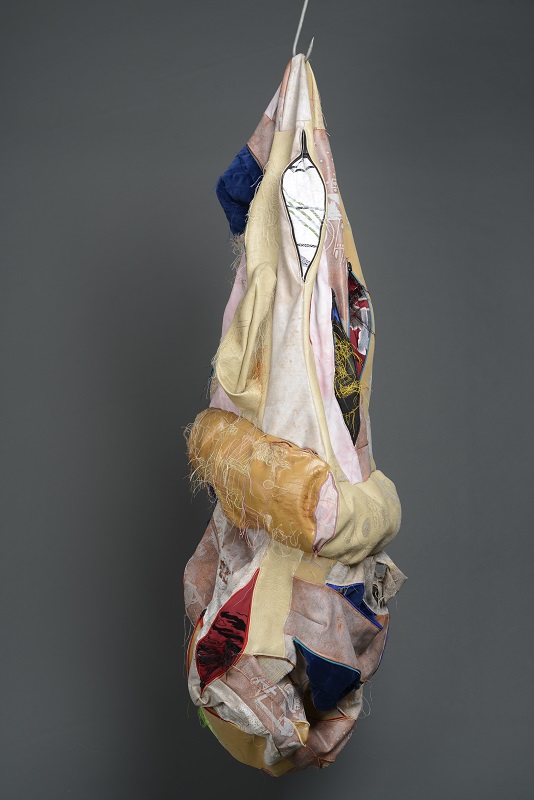
Nobody 1, 2014, leather, imitation leather, used clothing, velvet, hair, zips; stitch, print
Also, Nobody 3 is obviously knitted! Read more about how it became one of the Nobodies on my Knitting page.
Nobody 3, 2014, hand knitted wool, knitting needles
For details of most of my knitted soft sculptures, please scroll down. For my thoughts on knitting generally, please read my blog posts, I knit therefore I am and Stream of consciousness knitting.
Gallery of knitted works:
1. All the babies I might have had I, 2011, felted hand knitting
2. Chimera, 2019, felted hand knitting
3. Heart, 2013, hand knitted plastic tubing
4. Heart of darkness, diptych, 2016, hand knitting, knitting needles
5. Internal landscape, triptych, 2014, felted hand knitting
6. Internal monologue, 2018, hand knitting, knitting needles
7. Hand knitted plastic bags, 2019
8. Living sculptures, 2018, hand knitting, knitting needles at Make Space, Bristol Museum and Art Gallery, 18th July
9. Living sculptures, 2018, hand knitting, knitting needles at disquiet exhibition, Walcot Chapel, Bath, Sept.
10. Hand knitted red monofilament, 2018
11. Nobody 2, 2014, detail of felted hand knitting
12. Nobody 3, 2014, hand knitted wool, installed at Unravelling, Sept 2016.
13. Other 1, 2015, detail of felted hand knitting
14. Other 4, 2015
15. Other 5, 2015, detail of hand knitting
16. Other 5, 2015
17. Part of me 3, 2018, felted hand knitting
18. Parts of me, series of 6, felted hand knitting, installed at disquiet exhibition, Walcot Chapel, Bath, Sept
19. Patchwork fields, 2010, felted hand knitting
20. Patchwork fields, 2010, detail, felted hand knitting
21. Pillars of fire, 2019, hand knitting, knitting needles
22. Psychedelic sunset I, 2010, felted hand knitting
23. Psychedelic sunset II, 2010, felted hand knitting
24. Red tree trunk, 2010, felted hand knitting
25. Seascape, 2009, felted hand knitting
26. Self-portrait, 2012, hand knitting
27. Self-portrait, 2013, felted hand knitting
28. Shroud, 2013, hand knitting
29. Social network, 2012, hand knitted monofilament
30. The sea, the sea, 2017, detail, felted hand knitting
2019, I knit therefore I am, July -August
Knitting is like breathing to me, I knit wherever and whenever I can. It becomes performative. This video is part of an ongoing series capturing me knitting, this time on holiday in Costa Rica. I knit in public and in private, on planes, beaches, ferries, in a morgue, a tuk tuk, jungles and bars; everywhere! I've written more about it here. Check out my Performance page for more knitting and other performances....
2019, Chimera
chimera
/kʌɪˈmɪərə,kɪˈmɪərə/
noun
1. (in Greek mythology) a fire-breathing female monster with a lion's head, a goat's body, and a serpent's tail, any mythical animal formed from parts of various animals.
2. a thing which is hoped for but is illusory or impossible to achieve.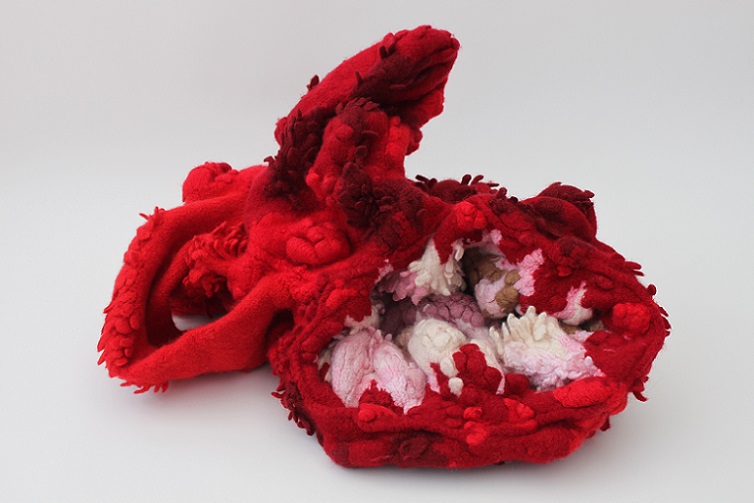
Chimera is a highly textured, hand knitted and felted soft sculpture. Its dimensions are approximately h 46 w 70 d 44 cm. It’s the largest piece I’ve ever felted. Its development is slightly different to that of most of my soft sculptures as it’s formed out of several separate pieces of red and flesh coloured knitting that I’ve knitted over the years. None of them were originally connected, except through colour.
As I like to knit whenever and wherever I am, I’ve been exploring ways to make modular pieces so that I can then knit them together to make one large sculpture. Chimera is part of that research. I already have quite a few fairly large, unfinished knitted pieces that are now too big to carry around so I decided to sculpt a soft sculpture by knitting some of these pieces together. Annoyingly, I forgot to take photos of them before I started, but here’s a photo of my friend, Maura, wearing some of them!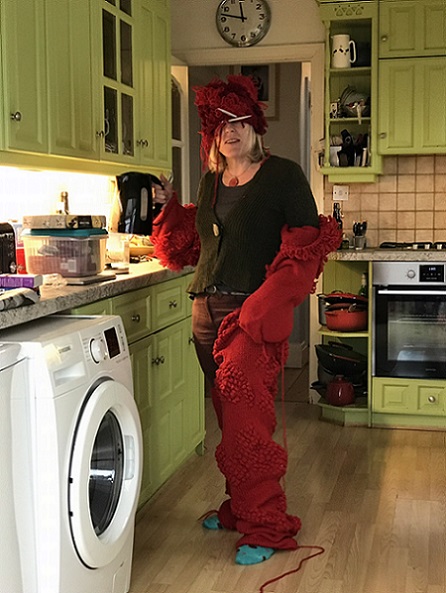
Maura Zukina as a #livingsculpture.
Follow my new Instagram account @_livingsculptures for regular updates on my Living sculptures project. See below and my Participatory and social engagement page for more details.
The leg and arm pieces are textured, knitted tubes. The head piece is actually an unfinished Part of me (see below). The largest part, which is not shown in this wonderful photo, is a large, sculptural round piece which I knitted during the final year of my degree, intending, possibly, to incorporate it into one of my stitched Others. It makes me realise that red and flesh colours have been part of my work for quite a few years! It seems appropriate that Chimera can also become one of the Parts of me series.
One of the reasons I felt liberated when I realised that my knitting skills transferred so wonderfully to making sculptures was that I never had to stitch knitted pieces together again. I can do it. I’m actually quite good at creating an invisible seam, but I really find it tedious. So, for Chimera, I decided to knit the pieces together. With some of them, it also involved adapting them slightly. With the tube, I increased it at both ends so that there was a flat end to knit to the next piece. I also had to knit quite a bit more of the flesh coloured piece so that I could merge the colours.
Here it is, on my kitchen table, beginning to take on its own idiosyncratic shape....
Then, eventually, I began to knit the pieces together. As you may know, knitting 2 pieces together leaves quite an interesting ridge. I see this as a visible mend, a suture, a scar, rough, gestural mark making. The process made me think of Frankenstein and the stereotypical expectations we have of his sutured monster. Chimera is my Frankenstein’s monster. I feel that this idea fits well with my ongoing explorations into Carl Jung’s individuation, where he says that balancing our multiple selves with the dark side of our self is a necessary part of growing older and ultimately leads to happiness and is a preparation for death. It is as if I have knit together some of my different selves, creating a quirky, distinctive whole.
Actually, as I reflect on this, I acknowledge that so much of my work has this as an underlying theme! Have a look at Nobodies, The Others, Parts of me, Living sculptures, The whole is greater than the sum of the parts, My imaginary friend, Shroud and probably more. My current project is another series of knitted sculptures, black and holey this time, which I’m fondly calling my Shadow sacks, referring to Bly’s analogy of the Shadow sack. I definitely regard my work as a form of therapy, and it interests me to think that some of my pieces are made of separate parts, in series, but that with others, I have joined them, either with knitting or stitch.
As I normally felt my work in my domestic washing machine, I had to be careful about the size of the final piece. Felting smaller bits of knitting brings body and sculptural form. I wanted this larger sculpture to hold its own form but I wasn’t sure whether there would be a tipping point where it would be too saggy! I generally don’t stuff my soft sculptures because I think that the unstuffed, empty, slumping nature of my felted pieces communicates loss, abjection. This time, I thought that I would try partially stuffing it and then felting it. I needed to use something that would survive several washes, so I used bubble wrap. It’s waterproof, light and will give form.
Chimera, before felting, stuffed with bubble wrap and ready to felt....
The final stuffed piece only just fitted in the washing machine! I usually add a large towel to the drum to help with agitation but this time there was no room. I normally quite enjoy the anticipation of a felting day, but this time I was much more nervous than usual. This alchemy, or change in control is an important part of my felted work, but it’s also very nerve racking. Months of labour intensive hand knitting culminates in a relatively short process which dictates the outcome. It’s definitely a form of madness!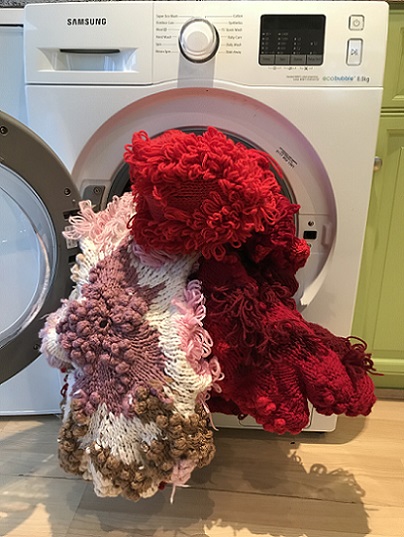
I knit with pure wool, Cascade 220, and after the first wash at 30 degrees my knitting normally felts enough to blur the stitches. I then normally wash it a few more times to get the extremely dense, felted surface that I prefer. This time, even after several cycles, it barely felted at all! After a few more washes it began to felt in rather strange ways: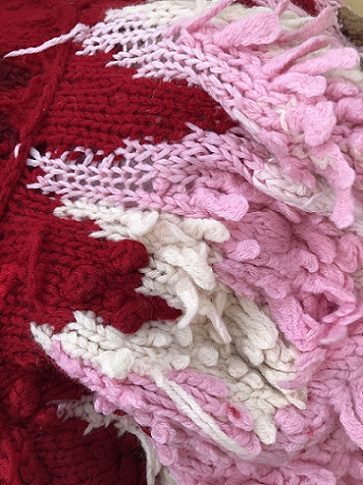
Even after a couple of washes it just started felting in rather strange ways....
I removed the bubble wrap and it worked. Phew. I was very pleased as the final felted piece has enough body to hold its own form. I could still stuff it though if I chose to, maybe with beanie bits?
This whole process made me realise that the size of my felted pieces will be limited by the size of my washing machine. I did consider whether I could sneak it into a launderette? I think my next experiment will be felting separate parts and then stitching them together with rough, visible seams. That might give an interesting effect…. Watch this space.
So, chimera has been successful! I’m very pleased. I’m also conscious that most of my knitted works need to hang but that many galleries might not consider hanging work. Chimera has been part of a move to make work that is free standing which could potentially be displayed on a plinth alongside other sculptural work.
And here are some more photos:
Oct 2018 and ongoing, Pillars of fire
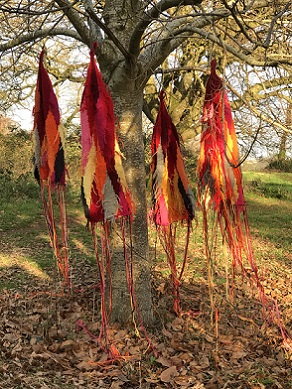
Pillars of fire is a series of 4 hand knitted soft sculptures. They are similar in dimension at the moment, and colour, but each one is different. They are a series in progress and number 5 is already under way! I knitted them in response to a call out for the Incendiary exhibition, curated by Patricia Brien. Incendiary was an exhibition of protest against the use of incineration in the disposal of waste, with specific reference to the new incinerator in Gloucestershire. In the end, however, my Pillars of fire weren’t selected. Instead, my site responsive, participatory installation, Tethering our thoughts, was part of Incendiary, and was well-received!
For Pillars of fire, I chose a range of colours associated with fire- reds, oranges, yellows – and also several greys and black to represent ash. For me, fire is associated with rage, and the idea of an installation of pillars of fire/rage appealed to me!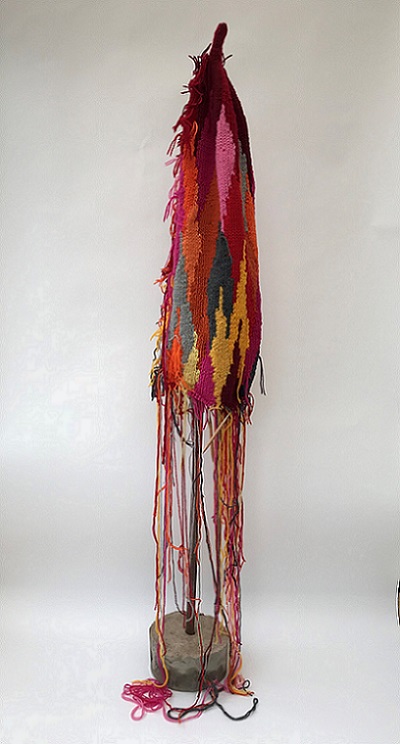
These are a development of my research into ‘hairy knitting’, where I show the workings of the process of my knitting. As I knit, when I finish a ball of wool, I tie in the next one, leaving a knot and two loose strands of distinctive length; when working with several colours, at the end of a block of colour there is usually a long tail of yarn, which I would normally cut short, but for these pieces, I left them hanging. These ‘hairy’ marks are a genuine part of my process of knitting but have a randomness to them which brings a curious change in control.
For Internal monologue, see below, I decided to show both the ‘front’ and the ‘back’ of the work simultaneously. For Pillars of fire, I’ve experimented with turning the pieces inside out and also pulling through the ends of yarn to the ‘front’. I think the latter is my preferred surface, but my thinking might change every time I install them! Either way, the final piece has a rather troubling, hairy surface. This subverts the stereotypical expectations of knitted work, which is usually functional, neat and cast off with all the ends woven in to the knitting so that they become invisible.
I have left each piece unfinished, on a circular knitting needle, which becomes part of the final sculpture. It could potentially be taken up and knitted, or it could be unravelled. Some of the loose strands of yarn are very long, so that they cascade from the sculpture, pooling on the ground, making their own spontaneous drawing on the floor.
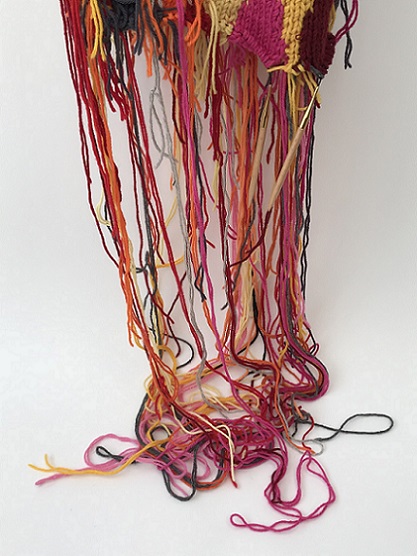
Most of my knitted work is very hard to photograph as it takes its form through tension and/or gravity. It needs to be installed. So, in January, I decided to photograph my Pillars of fire hanging in a tree. It was wonderful! Have a look at a video of them coming alive in the sunshine and being blown by the wind….
I’m very pleased to say that one of them has been selected for the RWA Sculpture Open, in Bristol. Have a look at my Exhibitions page for photos and more information about this. Knitting in a Sculpture exhibition, my knitting! I’m delighted that it’s there and thrilled that it’s the only knitted piece.
The Royal West of England Academy is a grand historical building with very ornate, and very high, ceilings. I realised that submitting a piece of knitting to this particular gallery meant that it couldn’t be hung from the ceiling, so I had to explore different ways to install it. Thus I experimented with a concrete stand and a pole and hanging it from a hook on the wall.
I offered both of these options to the gallery. I gather that, probably inevitably, they had fewer wall hung sculptures than standing ones so they chose to hang it on the wall.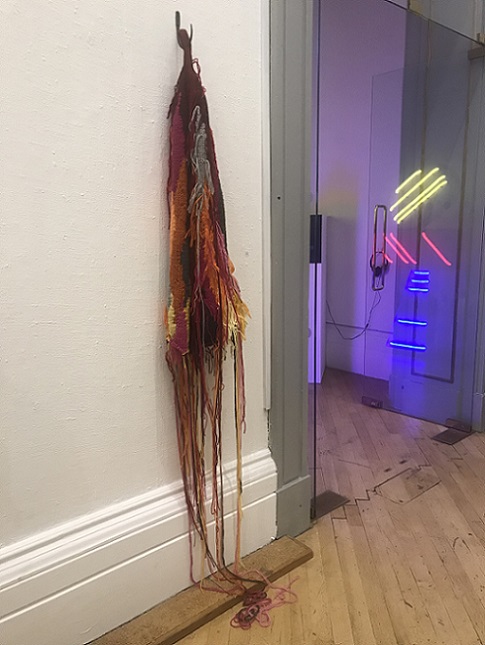
Pillar of fire I installed at the RWA Sculpture Open exhibition, 16.3 -2.6.2019
I like the way that knitting is literally so flexible. I definitely plan to install my Pillars of fire on stands at some point. I feel that the contrast between the concrete and rusty pole and the bright colours of the falling soft lines of yarn is very compelling.
I’ve also been thinking about making them much taller. I‘m very interested in immersive art and I think scale is often a key. Towering pillars of rage? Watch this space!
2018, Internal monologue
Update, Sept 2018: I exhibited Internal monologue at disquiet exhibition in September 2018. In the end I decided to hang it from a meat hook and chain so that both the right and the wrong side were potentially visible. 
It hung in front of one of Clare Thatcher’s paintings. I feel that its form echoes parts of the painting and that the two pieces resonate with one another in terms of form and colour. 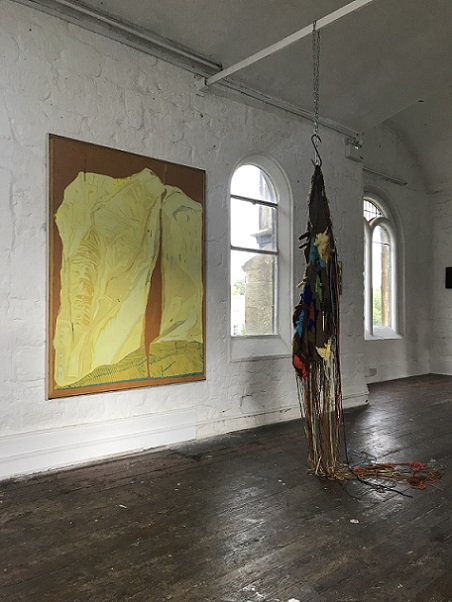
Its form at this point is a sculptural circle of knitting:
As described below, it could potentially be hung in many ways. I could also continue to knit it, as the needles are still attached. I’m not sure that I will, but maybe one day…..
I was interested that quite a few people wanted to touch it and examine it. I’m sure that’s partly because I invited visitors to try on my Living sculptures, which were nearby (see below). Permission to touch is unusual in an art setting, but textiles are extremely alluring. They’re people catchers, they need to be touched!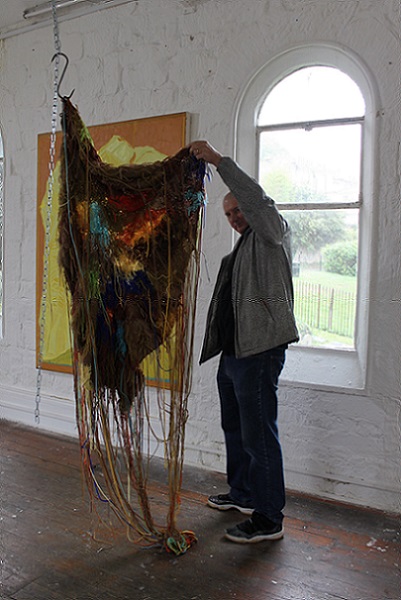
Here are some delightful videos of visitors interacting with Internal monologue:
1. Internal monologue moving spontaneously
2. A visitor interacting with Internal monologue
3. Another visitor wrapping herself up in Internal monologue
4. Yet another visitor twirling with Internal monologue
I’m intrigued by the relationship I have with this sculpture. I’m pleased with the protuberances; I shall knit more of them! I’m very interested in the hairiness, which is a consequence of being multi coloured, and about showing the ‘wrong’ side instead of the right side, but I’m not attached to it, in the way I am to most of my other knitted works. I wonder if it’s because of the palette? I definitely wouldn’t ever normally choose to knit anything with so many browns! Keep reading for more information about how Clare nd I responded to one another's work in preparation for exhibiting together. Have a look at my Exhibitions page for more images and details about disquiet generally as well.
And here are some more images of Internal monologue at disquiet:
July 2018:

Internal monologue being knitted on holiday in Italy, 4.8.18
Every summer I like to start a new piece of knitting just before I go on holiday. It means that I can take the maximum wool and bring back the maximum knitting! As is evident, I find knitting extremely relaxing so it’s my favourite holiday past time. I try to start something really complex as, for my holiday knitting, the more complicated it is, the better! Maybe that sounds strange, but Csikszentmihalyi suggests that the higher the level of skill, the deeper the state of flow…. and I do find complex knitting so utterly absorbing; it’s perfect for whiling away the hours in the shade.
This year I’ve been working with another artist, Clare Thatcher, preparing for a joint exhibition in September 2018. Clare paints landscapes in oils using pure pigments. Her work is subsequently very textures and her use of colour is wonderful! Although we use such different materials and processes we recognise similarities in our work so decided it might be an interesting challenge to swap work and make new work in response to the one another’s work.

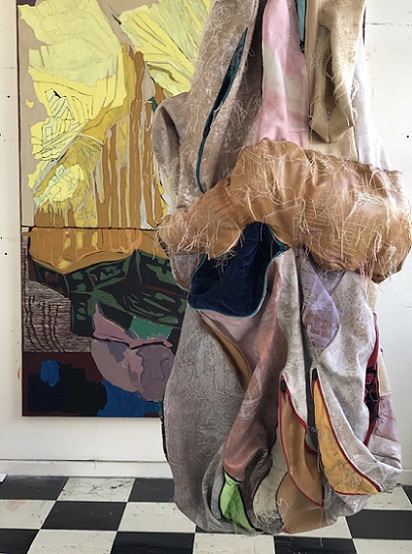
My stitched soft sculpture, Nobody 1, in front of one of Clare Thatcher's oil paintings, Feb 2018
These are the pieces that I brought home with me in February 2018:

 One of Clare Thatcher's oil paintings
One of Clare Thatcher's oil paintings

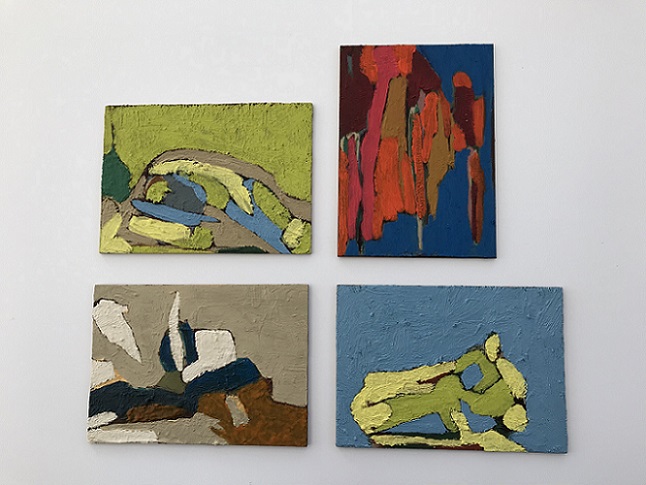
A series of 4 of Clare Thatcher's studies in oils for larger paintings.
These are some of Clare’s smaller works. The set of four are studies for larger pieces. I chose a range of browns and other colours from this palette. It’s definitely a very different selection to the colours I have worked with before and it has been an interesting experiment.
In terms of form, I wanted to revisit the peak-like protrusions that I used at the centre of last summer’s big knitted piece, The sea the sea (see below). They’re quirky and fun and hard to knit, so that was perfect. I have to knit each piece with double pointed needles and then knit it into the larger knitting. It’s complicated and labour intensive so it’s been great for my holiday knitting.
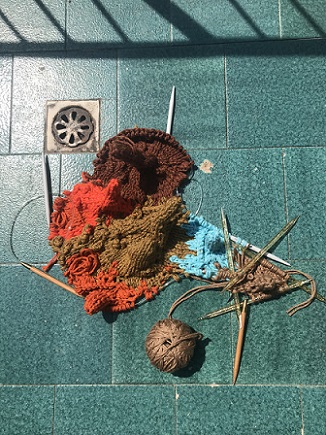
Sculptural knitting, 29.7.18
Since coming home I’ve been aware of the time pressure of the September deadline so have been concentrating more on the browns. I definitely don’t find it as motivating to knit browns as I do the other colours!
Most recently I’ve been thinking of how I’ll exhibit it, debating whether to show the ‘wrong’ side instead of the ‘right’ side. I’ve also been exploring ways to show both. I'm intrigued by the visual impact of the reverse, but also intention vs lack of intention, the mark making, the marks of my making, the change in control and maybe the ‘unconscious intentionality’ of it. It would be conceptually interesting to ‘just’ hang it inside out but I have to confess I'm feeling conflicted, as many, many hours and many years of accumulated skill have gone into the making of this large knitted soft sculpture. I'm at the point when I need to begin to sculpt the piece into a particular sculptural form if I’m going to show the wrong side, whereas if I want to show both sides it will probably need to have a different shape. Maybe I’ll use a mirror? 
Right side or 'wrong' side? 27.8.18
I’ve been looking at David Pye’s workmanship of risk versus the workmanship of certainty and Elaine Cheasley Paterson and Susan Surette’s book ‘Sloppy craft’. I’ve also trialled some installation ideas. I do realise that, as knitting is literally so flexible, I could potentially install it in many different ways in the course of the week of this next exhibition. Maybe that’s what I’ll do!
One of the allotment installations, 3.9.18
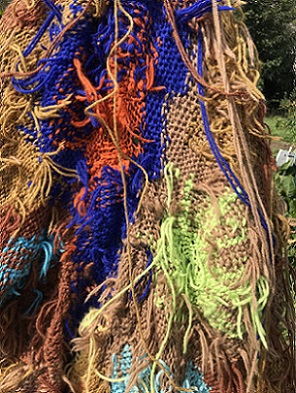
'Wrong' side, detail
The colours of my new, knitted Living sculptures, see below, have also been strongly influenced by the vibrant colours that Clare uses.
Do come and see what I decide to do with it all. The exhibition is ‘disquiet’ at Walcot Chapel, Bath, UK. It’s a disused mortuary chapel, so will be a very atmospheric space to exhibit in. It opens on Sept 18th 2018 and is open daily from 11-5. The private view is on Sat 22nd from 2 – 5pm and everyone’s welcome.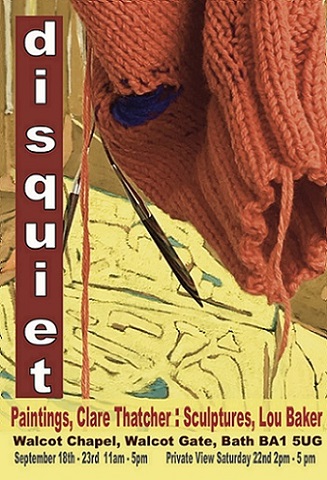
The flyer for disquiet, featuring details of another of Clare's paintings and one of my Living sculptures.
Also, the title is a working title so watch this space….
Here are some images of the stages of knitting Internal monologue and some more trial installations:
1. 23.7.18 Knitting in the car. It begins!
2. 29.7.18 Knitting on a shady terrace after breakfast, Cetara, Italy
3-5. Knitting by the sea, 4.8. - 7.8.18, Castello Giusso, Vico Equense, Italy
6. ‘Right’ side, 8.8.18, with Vesuvius in the background!
7. ‘Wrong’ side, 8.8.18
8. ‘Right’ side or ‘wrong’ side? Perranporth, Cornwall, 27.8.18
9, 10. Allotment installations, ‘wrong’ side, 3.9.18
11,12. Allotment installations, ‘right’ side
13. Right side and wrong side
14. ‘Wrong’ side, detail
15, 16. Clare Thatcher's paintings that inspired me
17. My soft sculpture, Nobody 1, in front of another of Clare's paintings, Feb 2018
Living sculptures, hand knitted wool, knitting needles, April 2018 – present
Update, September 2018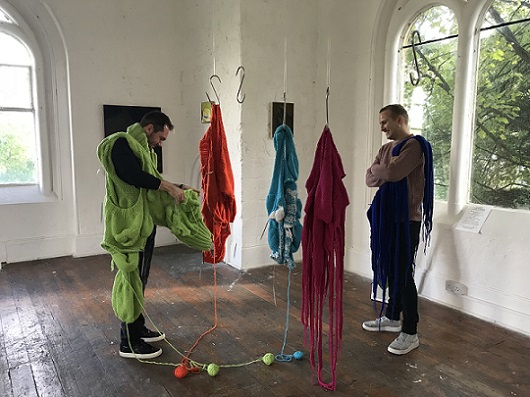
Two participants wearing my Living sculptures at disquiet exhibition, Walcot Chapel, Bath, Sept 2018
I have now also trialed my knitted Living sculptures for a week during the disquiet exhibition at Walcot Chapel in Bath. Have a look at the full documentation and research so far, including the thinking behind the work and many wonderful images of participants becoming Living sculptures. There's also more information about this project on my Participatory art and social engagement page. 
Click on the image above to find out more about Living sculptures.
Update, August 2018
Living sculptures, exhibited as a work in progress as part of my interactive event at Make Space at Bristol Museum for a day on July 18th 2018. They work well as static sculptures as well as wearable ones!
‘Living sculptures’ is a series of wearable hand knitted soft sculptures. Normally, in an art gallery, there are signs saying ‘Do not touch’; what happens if the viewer is not only encouraged to touch but is invited to become a living sculpture by wearing an abstract soft sculpture? What would it look like? How would it feel?
Most of my static soft sculptures are technically wearable, and at some point during the process of making, I try on all my sculptures. It’s part of making them me and is also part of my ongoing research into the links between clothing, body and identity. Yet they are, realistically, utterly unwearable.
This is part of a larger body of work in progress where, using traditional garment-making skills and unexpected materials, I am developing a selection of more readily wearable sculptures which can be put on and removed independently by visitors. The passive viewer can choose to become an active participant, a performer; or, for the onlooker, the space will be transformed into a dynamic, ever-changing, interactive experience.
I have trialled the participatory aspect of this idea as part of a day at Bristol Museum’s Make Space alongside The Woman’s Hour Crafts’ Prize exhibition in July 2018. I provided mirrors and some static soft sculptures for photo opportunities. Feedback indicates that the participants found it playful and fun but that it also provoked a range of conflicting responses. I documented the event with photos, videos and interactive feedback and feel that it was highly successful. I’m planning to add to this series and provide further opportunities for a larger, more immersive experience.
Here are some images of the Living sculptures event at Bristol Museum:
And here are some of others wearing them, including my mother!
I think they're are also very interesting as more static hanging, soft sculptures. I'm still knitting them, so they're growing and multiplying. They are my 'public' knitting at the moment, as they're relatively small! I plan to exhibit them as a hanging series at my next exhibition, disquiet, at Walcot Chapel, Bath from September 18th-23rd. Do come and see them.
Here are some photos of them hanging. More to follow!
April 2018: I have finally started making a series of more wearable soft sculptures! For a number of years I’ve been planning this, but have been motivated to start by being asked to run a Living sculptures day on July 18th as part of Bristol Museum’s ‘Make Space programme’ which will run alongside The Woman’s Hour Craft Prize exhibition from 7th July to 2nd September, 2018. They have invited local makers to provide hands on craft experiences for those visiting the exhibition.
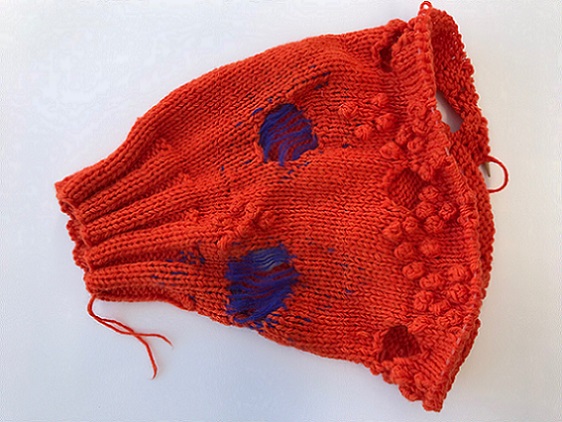
Living sculpture, orange with blue darning
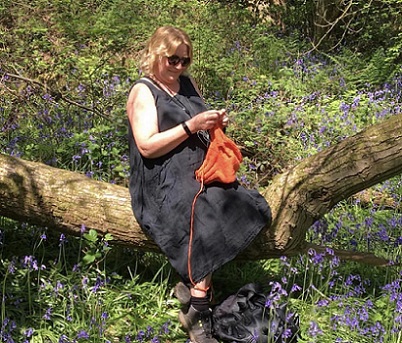
... and here I am knitting it amongst the bluebells! 10.5.18, Priors Wood, near Bristol
At some point during the development of each of my soft sculptures, I wear it so I have a selection of surreal and wonderful photos as a result. As there is a performative element to this ritual, many of the images are on my Performance page. I call them Wearing the unwearable. My plan for this project is to make some more readily wearable sculptures that the participants can try on independently. I like the idea of enabling the passive viewer to become a living sculpture, an active participant. It will, hopefully be a dynamic, ever changing environment, a spectacle for the onlooker and enjoyable for the participant.
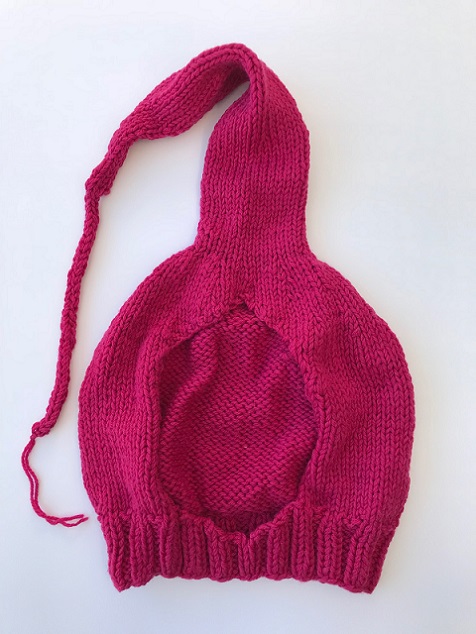
Living sculpture, pink is a bit like a pixie's balaclava so far.....
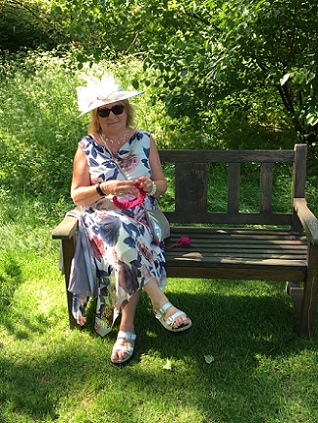
... I sneaked the beginnings of this piece into a Buckingham Palace garden party. Beautiful gardens. Notice the ER carving on the bench! 15.5.18
As this needs to be a family-friendly event, I’m hoping that it will be playful, prompting curiosity and thoughtfulness about the links between what we wear and our identity. The sculptures will need to be suitable for all ages, shapes and sizes; quite a challenge!
I have chosen a selection of bold bright colours and have started by knitting some specific garment-like features so that the sculptures will have strong associations with clothing. I also plan to make some stitched sculptures.
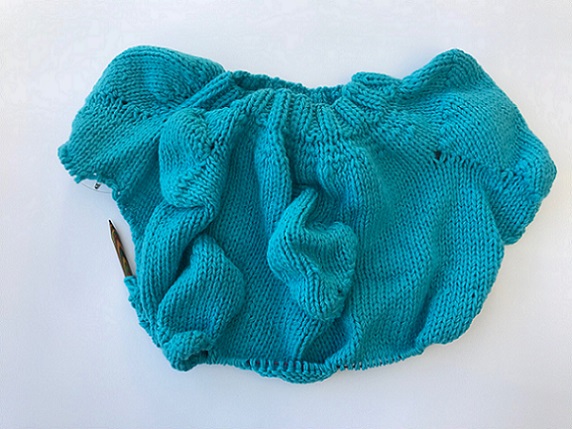
Living sculpture, turquoise....
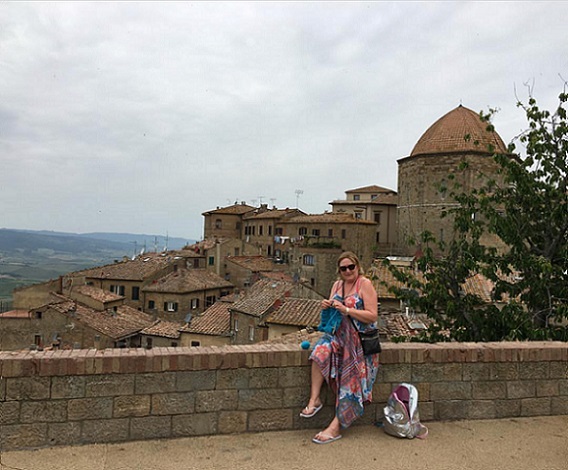
...being knitted in Volterra, Tuscany at half term, 29.5.18
I think I’m going to hang the finished sculptures on hangers and provide mirrors so that the living sculptures can take selfies!
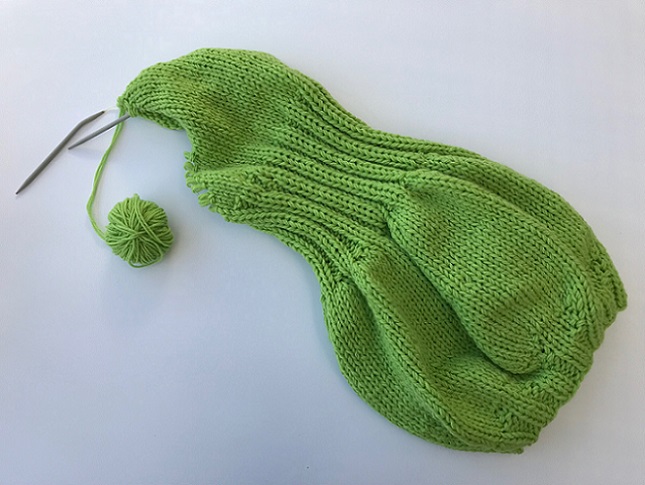
Living sculpture, green
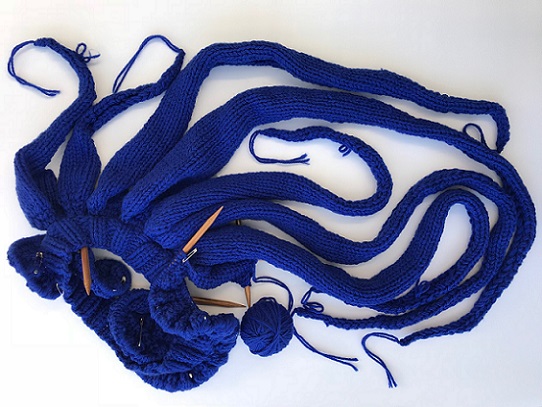
Living sculpture, blue, my favourite so far! I love the movement of the tentacles.
It interests me that what I have made so far are a bit like body parts at the moment…. its definitely because I like to knit when I'm out and about so I've started five pieces so that they're small enough to carry around. Each one will soon have to be knitted at home, more privately as it becomes too large to transport easily. I might decide to leave them as wearable 'parts', or I might make full body sculptures. I haven't yet decided....I also might felt them....Watch this space! Come back and see how they develop over the next few weeks and join me at the museum on July 18th to become a Living sculpture!
Feb 2018 and ongoing, I knit therefore I am
I find it hard to categorise I knit therefore I am, 2018. It isn’t a performance, yet it is performative; I do genuinely knit whenever and wherever I can. It is about knitting, but it isn’t about one soft sculpture. This 2018 series of images began when my lovely, supportive and long suffering partner, Dave, started taking photos of me knitting on our travels. It obviously doesn’t record every time I knit in public, but it does capture what I see as the quirky and humorous eccentricity of my habit! It’s also a record of many lovely days away together; I seem to have knitted on many beaches in the sunshine from February onwards! Can this really be in Great Britain? How lucky am I.
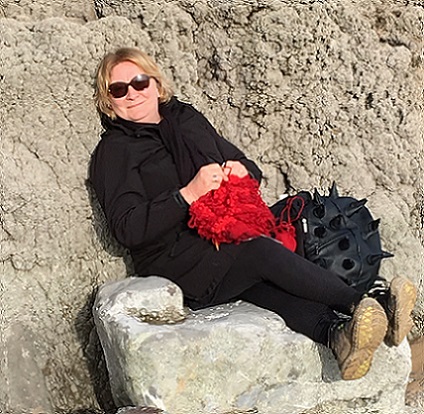
Knitting Part of me in the sunshine
at Barafundle Bay, Pembrokeshire, February 2018. Bliss!
This is a sequel to I knit therefore I am, 2012, which is documented on my Performance page. Then, I was documenting when and where I knitted as a project for University and it was driven by me. Interestingly many of those images are indoors and possibly more private. I don’t think my habits have changed, I just think that this current series has been led by my partner so it has a different emphasis. Often it’s about who’s available to take a photo and if we remember! Knitting is so much a part of the backdrop of my life that it’s normally not memorable, so we forget to capture the moment.
I have some knitting with me at all times, and if I have a moment to sit and knit, I take it out, wherever I am, and fall into the pleasure and rhythm of knitting. I knit on the bus, the train, as a passenger in the car, in the pub, on the beach, by the pool, on the ski slope, during lectures, at meetings, in church, in a queue, in cafes and restaurants, at weddings, football games, The Olympics, concerts and anywhere else I go. I’ve even knitted at Buckingham Palace! My family and friends barely notice. Knitting in public is, however, a people magnet. Strangers often come and ask me what I’m knitting. Sometimes, I’m bold enough to explain (My uterus? A shroud? A piece based on Jung’s individuation?) but often I just say that I’m an artist and I’m knitting a soft sculpture. The only places I don’t knit have been at my son’s school events (too embarrassing for him), the cinema (too dark) and at airports (not allowed, although fortunately this is changing!) I don’t think I’ve ever knitted at a funeral either. There are obviously other places and times when I feel it isn’t appropriate to knit as well.
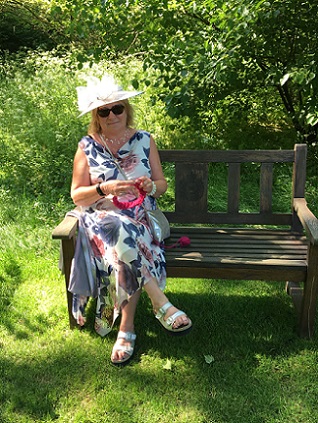
I had to sneak some circular needles and a tiny ball of wool into my bag
when my partner was invited to a garden party at Buckingham Palace!
Notice ER carved on the bench!
I'm knitting Living sculpture, pink.
15th May 2018
I sometimes wonder why this habit began and I’ve decided that there are multiple reasons. I think it began when I started making large sculptural pieces. In order to get enough knitting done, I need to knit for as many hours as I can. I also find that when I knit it becomes a stream of consciousness so in a way it’s better to not give it my full attention. Talking, watching TV, listening to an audio book; the knitting flows better when part of my mind is occupied with something else.
I find it hard to regard knitting as work. I rarely start knitting by myself at 9 o’clock in the morning. It makes me feel oddly guilty as I associate knitting with leisure and pleasure. If I try to see it as work, I find that I lose some of the pleasure in it.
Knitting alone is different; I quickly enter a peaceful, meditative state and time flies. Knitting sets my mind free so I can think differently. I often find solutions to problems, have ideas and remember things while I’m knitting.
Knitting in public, I need to keep part of my mind alert to those around me. It interests me greatly that knitting helps me to concentrate. I’m obviously a kinaesthetic learner! I sometimes wonder too whether knitting is a much healthier and less antisocial replacement for smoking. Although I gave up smoking 28 years ago, I still find that having something to do with my hands helps me in many social situations.
I find that I actually do more knitting with others or in public than at home alone and I probably do most knitting when I’m on holiday. Then, I will allow myself to happily knit all day!
Knitting calms me, almost instantly; it’s like a form of therapy for me. Not being able to knit in airports and on planes has been quite an issue for me as I’m very anxious about flying. Fortunately, attitudes towards knitting have been changing recently and the last time I flew, in May 2018, I was able to knit again on the plane, which was a huge relief.
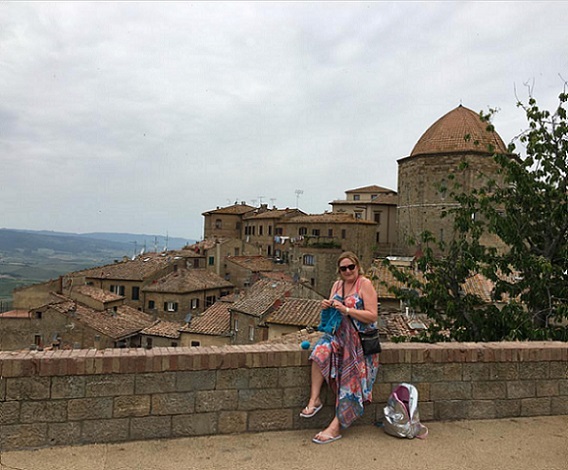
Volterra, Italy, May 2018. Knitting with a view!
I have also only recently acknowledged the importance of 'knitting in public' in my practice. When this series of images started I had just decided to knit some smaller soft sculptures, Parts of me, for a multi part installation. I wanted to have portable pieces of knitting at all times. Each time we went away, I'd start a new Part of me so that I had a piece of knitting that was small enough to take in my rucksack. I feel that it has become a poignant snapshot of my life as, once the sculpture became too large to carry easily, I changed the colourway and knitted it more privately to finish it. I have a feeling that this model of knitting parts, or fragments, of a sculpture is now firmly embedded in my life and my practice. I have now started knitting my Living sculptures in a similar, fragmented way.
Sadly, I forgot to get Dave to take a photo of me knitting on World Wide Knit in Public Day 2018 on 9th June so I put together this montage of me knitting to post on social media:
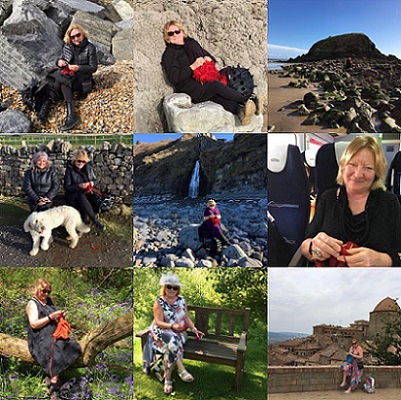
I am delighted that, as a result of these images, I’ve won 2 tickets to the London Knitting and Stitching Show! I’ll make sure to post a photo of me knitting there as well.
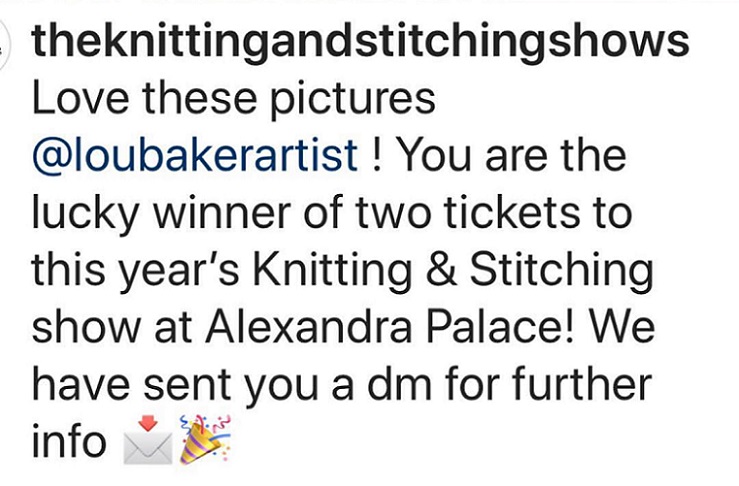
Follow me on Instagram, Facebook and Twitter for regular photos of places I’ve knitted.
And here are some more photos:
1. Barafundle Bay, Pembrokeshire, 16.2.18
2. Overlooking Caldey Island, near Tenby, Pembrokeshire, 16.2.18
3. Saundersfoot, Pembrokeshire, 17.2.18
4. Worm's Head, Gower, with Lucy and Wolfie, 10.3.18
5. Bucks Mills, North Devon, 25.3.18
6. Rottingdean, West Sussex, 31.3.18
7. Worthing, West Sussex, 1.4.18
8. Priors Wood, Portbury, near Bristol, 5.5.18
9. Buckingham Palace garden party, 15.5.18
10. Volterra, Tuscany, Italy, 29.5.18
11. My I knit therefore I am montage for World Wide Knit in Public Day, 9.6.18
12. My Instagram post for WWKIPD, 9.6.18
13. Winner!
Current work
2018, Knitting with red monofilament
1, & 2., 21.1.18, 4mm circular needles
3. & 4.,1.2.18, 10mm circular needles
2017 and ongoing, Parts of me
Update, August 2018:

Parts of me installed in a cell at the Subversive surfaces exhibition in June and July 2018
I have completed 6 Parts of me so far, with a seventh still to be finished! I was delighted to have the opportunity to install all six in a disused basement prison cell for the Subversive Surfaces exhibition at Town Hall Arts, Trowbridge for a month, from 9.6.18- 14.7.18. It’s a listed building so we couldn't make any holes anywhere so I decided to create an immersive walk-in installation. I suspended the soft sculptures from the bars by stitching through each one several times with wool and tying them in place. It was a bit like stitching them to the cell! I think it worked really well. The setting was particularly atmospheric which added to the immersive nature of the installation; it was dark, cold, damp and creepy! I’m looking forward to exhibiting them in other ways too.
Here are some images of the whole installation and some details too:
Parts of me will be a multi-part installation of smaller, hand knitted and felted soft sculptures. Who knows how many there will finally be? 
Part of me 6 on Worm's Head, overlooking Rhossilli beach, Gower, 10.3.18.
I started knitting it over breakfast as Part of me 5 was getting too big to take on walks!
Each knitted piece is an exploration of the relationship between inside and outside, both physically and metaphorically; what is seen and what is unseen, the public and the private.
Knitting in public: Part of me 6 on Worm's Head,
with Lucy and Wolfie
Knitting in public: Part of me 4 in the sunshine at Barafundle Bay, Pembrokeshire, 16.2.18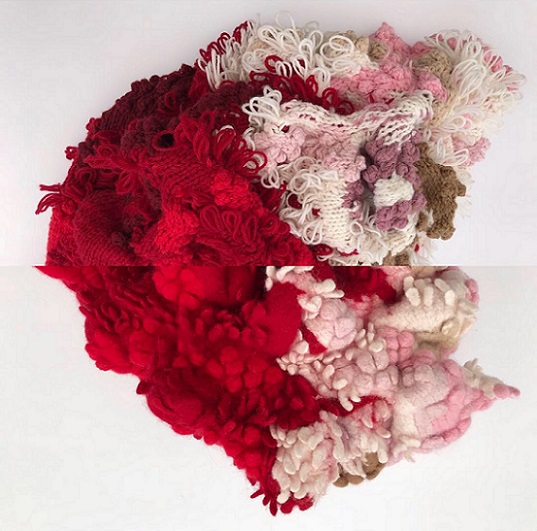
Part of me 3, 3.3.18, before and after felting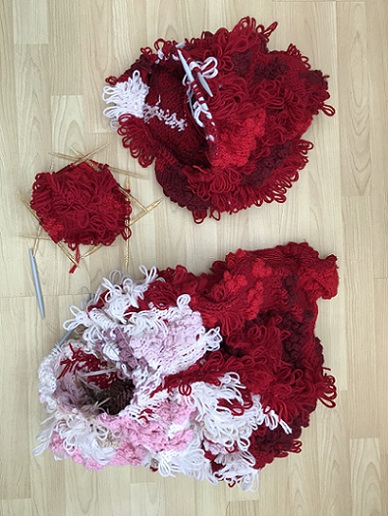
Parts of me 3, 4 & 5, hand knitted wool, 1.3.18, work in progress
Each soft sculpture is knitted in public until its too big to carry around
then I knit it in private and start a new, public Part of me
Part of me 1, installed at Synecdoche's Opposing positions exhibition
at Southmead Hospital, Bristol, July 2017
Each Part of me is knitted in pure wool in one piece, in the round. The first half, the outside, of each I knit in a range of reds as a stream of consciousness. I start with double pointed needles, increasing as I work to sculpt a cone-like structure, knitting random protrusions and using bobbles and loop stitch to add texture. As the circumference increases, I move on to a circular needle and then several circular needles until I reach what I decide is the centre point when I start to decrease. Then I begin to introduce whites and flesh colours and also continue to decrease so that the second part, the inside, is like a warped mirror image of the first half. Each Part of me is a different size, and, inevitably, each has its own idiosyncratic identity.

Part of me 2, ready for felting
Felting produces a disquieting change in control, transforming the familiar, comforting, recognisable knitted fabric into something ‘other’, body-like and strange. Sometimes it seems like a form of madness; months of slow, meditative work culminate in a relatively short, unpredictable process of alchemy which dictates the outcome. I felt my work using a domestic washing machine and often felt it more than once to reach the required texture. Each piece shrinks by between a third and a half in every direction, depending on certain parameters. Its unpredictability is part of the appeal, but can be very nerve racking!
I am always interested in finding ways to make self-sustaining sculptures with knitting and stitch. Although in some of my work I use a stand to provide support for my sculptures, for example in Other 3 and Other 4, I find it more pleasing when a sculpture doesn’t need any extra support. All my hanging sculptures, Nobodies, the other Others, Heart of darkness and All the babies I might have had I (scroll down for more information) are examples of this. I use various devices in addition to felting, like combinations of materials of differing rigidities, quilting, tension and gravity to give form to my work.
This new series explores different ways to make self-sustaining soft sculptures. This time my research is based on felting and the intrinsic design. I knit with 2 strands of Cascade 220 pure wool on size 8 needles. For some sections of the knitting I use Fair Isle, or stranded, knitting, when the unused colours are woven in at the back of the work until they’re needed again, so my knitting can sometimes be up to 8 strands thick. The rest of the colour work is intarsia and, as it’s mostly knitted in the round, I have to frequently break off the yarn and add a new colour. This inevitably involves knitting in lots of ends which gives the subsequent felted fabric wonderfully varied substance and body. I have also designed these sculptures so that when the second half of the knitting is pushed into the first half after felting, the sculpture supports itself. It has worked with Part of me 1 but Parts of me 2 and 3 are substantially bigger so it’ll be interesting to see how they turn out. I’m hoping there will be some interesting slumping, another change in control!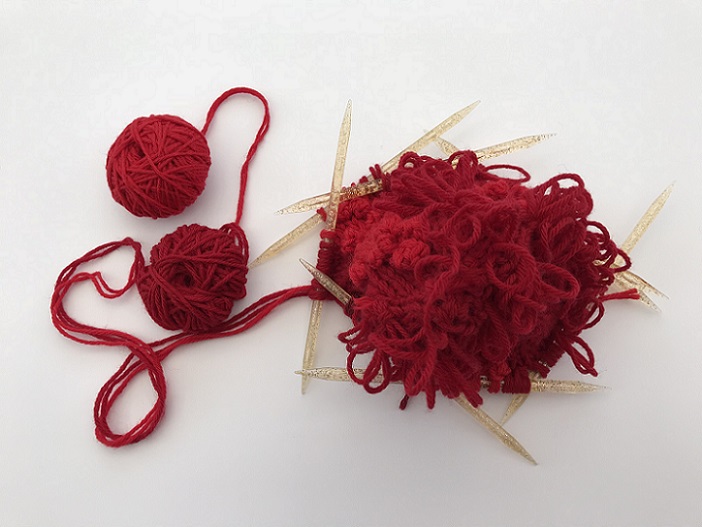
Part of me 5, as public knitting, started 26.2.18
Images of Part of me 5:
1 & 2 Part of me 5, 1.3.18
Images of Part of me 4: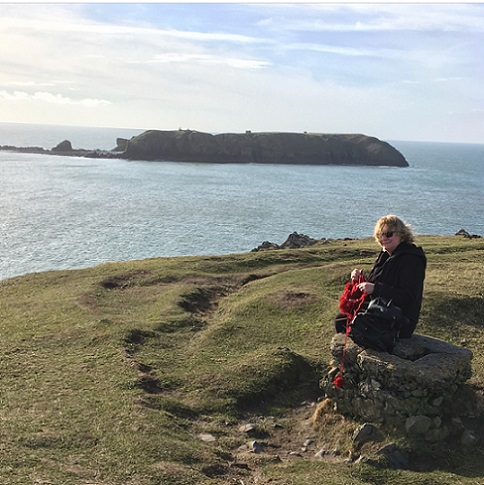
Knitting Part of me 4 on Giltar Point, Pembrokeshire overlooking Caldey Island, 16.2.18
1 & 2. Part of me 4, 5.1.18
3 & 4. Part of me 4, 1.3.18, beginning to knit the inside, adding flesh colours and decreasing
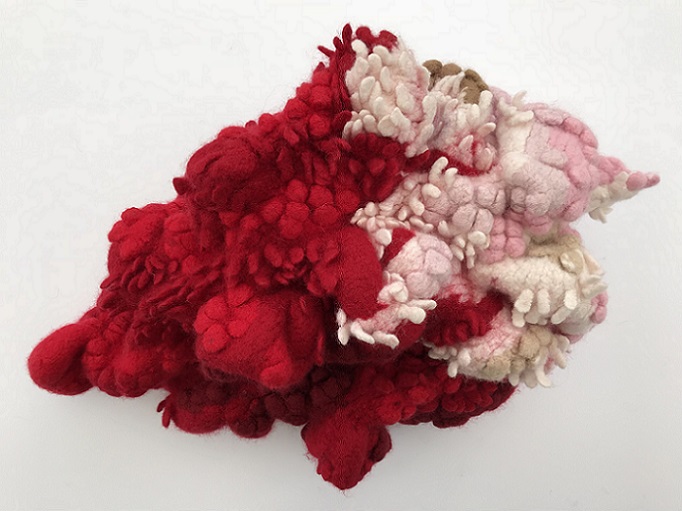
Part of me 3, final dimensions 54 x 33 x 22cm approx.,
finished and felted, 3.3.18
More images of Part of me 3:
1. Part of me 3, 24.11.17, knitting begins on double pointed needles
2. Part of me 3, 5.1.18, mid-point reached, working on 3 circular needles adding in flesh colours and beginning to decrease
3. Part of me 3, 1.3.18, working on 2 circular needles, continuing flesh colours and decreasing
4. Part of me 3, 3.3.18, finished and ready to felt! Dimensions before felting 80 x 54 x 18cm
5. Part of me 3, 3.3.18, a nerve racking few hours as the piece is washed 3 times, once at 30 degrees, twice at 40, to get the right consistency of felt
6 & 7. Part of me 3, felted. Final dimensions 54 x 33 x 22cm
8. Part of me 3, before and after felting
9. Part of me 3, dimensions before and after felting
I decided to knit multiples for a number of reasons, some aesthetic and some highly practical, and also to try something new. I enjoy multiples that are essentially the same but where each one is subtly different. I think it's visually interesting. As I have discussed in my blog, I knit therefore I am, I do knit whenever and wherever I can so the size of my knitting is important. I often find that I knit something out and about, my ‘public’ knitting, until it becomes unwieldy. Then I knit it more privately, at home. The public knitting tends to be done in the company of other people, in the pub, over lunch with a friend, on the beach. Obviously with the private knitting, I’m more often alone, or with my family. When I’m alone I do very quickly enter that addictive state of meditative timelessness, the state of flow….
Other practical aspects of multiples are storage, transport and installation. Yet another is that I’m not sure how large a piece of felt would sustain itself in this way. I hope to find out!
It wasn’t until I began to write this that I realised that, inevitably, the first half of each of these sculptures, what becomes the outside of the finished piece, tends to be knitted more publicly. As it gets to a size that is harder to carry around I then knit the second half, the inside, more privately. Much of my work makes public things that are normally private so this added, unexpected aspect thrills me. Although each half requires the same skill, time and effort to knit, the details of most of the inner, second half are largely unseen. This feels apposite! I’m knitting hidden innards. Weirdly wonderful! Love it.
I also really like the fact that, before too long, I probably won’t be able tell the Parts of me apart....
January 2018: With Part of me 2 I decided not to fold the 'private', flesh coloured part of the knitting into the sculpture. I am delighted that it holds its form just with the density of the felt even though its so much larger than Part of me 1. I might still change my mind though! Part of me 3 is bigger still, so I'll be interested to see how that works out....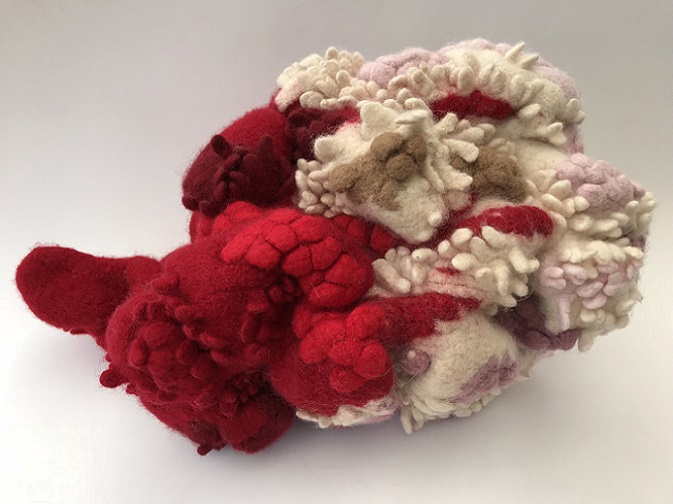
Part of me 2, hand knitted felt, 46 x 28 x 24cm, 5.1.18
More images of Part of me 2:
1. Part of me 2, work in progress, second half on circular needles using flesh colours and decreasing, 29.10.17
2. Part of me 2, work in progress, changing to double pointed needles, 24.11.17
3. Part of me 2, work in progress, detail
4. Part of me 2, knitting completed, ready for felting, 5.1.18
5. Part of me 2, knitting folded in on itself, 5.1.18
6. Oh that chamge in control! Felting in the washing machine, 5.1.18
7.& 8. Part of me 2, January 2018
9. Dimensions of Part of me 2 before and after felting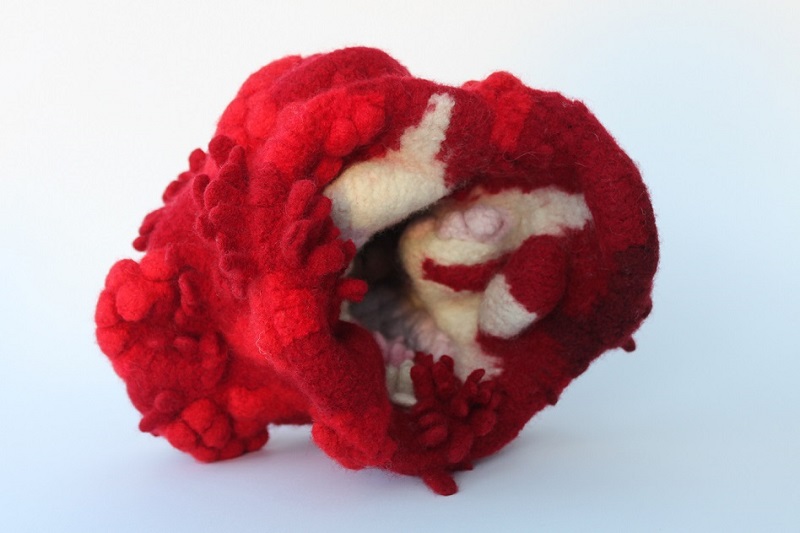
Part of me 1, felted hand knitting, completed 2.7.17
20 x 20 x 21cm approx
More images of Part of me 1:
1. Part of me 1, 2.7.17, before felting
2-4. Part of me 1, before felting, with the inside folded into the outside
5-8. Part of me 1, after felting
9-11. Part of me 1, exhibited at Synecdoche’s Bodies exhibition at Southmead hospital, Bristol, August 2017. Here it was suspended with red wool in a locked glass cabinet above Gina Baum’s ceramic sculptures.
12. Dimensions of Part of me 1, before and after felting
22.7.17 - 29.8.17, The sea, the sea
I was delighted to be invited by the Embroiderers’ Guild, as a former Embroiderers' Guild Scholar, to submit a piece of work to their exhibition, Page 17, which was shown at The Knitting and Stitching Shows in London and Harrogate in October and November 2017. It is now touring and will be exhibited at The Fashion and Embroidery Show, NEC Birmingham, Harborough Museum, Market Harborough and Artrix, Bromsgrove during 2018. For details of dates etc please see my CV. Although the exhibition was organised by the Embroiderers’ Guild, they were keen for it to showcase a diverse selection of textile art so I decided to hand knit the sea, as one does!
I often choose to knit the sea when I’m by the sea. As well as being a compulsive knitter, I am also a compulsive swimmer so I find that being able to be immersed in the waves, as well as watching and smelling it, is the best research possible. Consequently, I have knitted several incarnations of the sea before now during holidays on the coast and it’s something I come back to with great pleasure each time.
Knitting on the beach at Putsborough, North Devon, August 2017
The brief for Page 17 was for a piece of textile work inspired by a book. The book that I chose is Iris Murdoch’s The sea, the sea which had a profound impact on me when I first read it in my early 20s. It’s a story of the sea, love and obsession, all of which seemed apposite!
I found it interesting to work within the constraints of this particular brief. The work had to be mounted on a canvas no bigger than A2 and was only allowed to project from the canvas by an inch. This was hard for me as my work is normally much larger, sculptural, organic, and definitely not rectangular! I decided in the end to use circular needles to knit a highly textural, two dimensional piece. It was very difficult to knit, but I love setting myself challenges, and, for me, the more complicated a piece of knitting is, the better. It was wonderful to extend my sculptural knitting skills in so many different ways. I would normally use circular needles to knit largescale, sculptural pieces; using this technique to knit something flat, which also had to be roughly rectangular, was an exhilarating piece of research and consequently totally absorbing.
I knitted intensively throughout the summer whilst we were on holiday and back at home, on the beach, by the pool, in pubs and on the bus, sometimes for 5 or 6 hours a day. Blissful obsession! When I knit I very quickly enter a state of meditative timelessness where time flies….And I’m happy….. (further reflections on knitting are documented elsewhere in my blog article I knit therefore I am…..)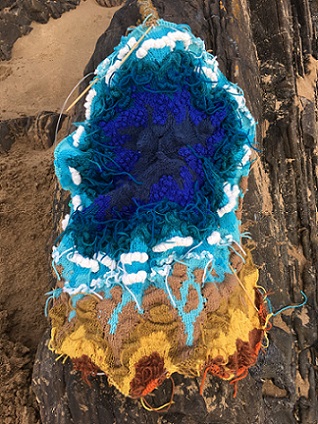
More knitting on the beach
I absolutely loved knitting The sea, the sea but frankly I’m not sure about the final piece. I vacillated about leaving it knitted or felting it. Knitting has a familiarity to it which has a range of particular associations to do with comfort, the body and femininity which I have come to appreciate more and more. Felting transforms the knitted fabric into something more alien, less instantly recognisable, distorted and definitely more sculptural. It becomes ‘other’. One issue with felting is that you have to knit something very large which you then deliberately shrink. Madness! Months of labour intensive work culminates in a relatively short unpredictable process of alchemy which brings a change in control. It’s a nerve racking time as, obviously, felting is final and utterly irreversible. It’s often a hard decision to make.
In the end I did decide to felt it, mostly because of the size, partly because I thought it would be be easier to mount if the surface was denser, and partly, I admit, because it’s much quicker to cut off felted ends than to stitch in every hanging piece of wool! I am always much more interested in the process of knitting than the finishing.
I had planned that the knitted felt would be larger than the canvas so that it wouldn’t be visible but it seems that my felting calculations went awry! The knitting shrank much more than I had anticipated, probably because it was knitted in the round. The joys of that change in control! In the past I have successfully planned for specific sized pieces of felted knitting, but it is a hard thing to do. It’s just a very unpredictable process, which it one of the things I normally enjoy about it.
The sea, the sea, felted and mounted
In retrospect I realise I also should have allowed more time to take into account these vagaries; if I had I might have been able to come up with a better way of mounting it. As it is, sadly, I think the rectangle of white canvas is an eyesore. An important lesson to learn!
Unfortunately as well, such intensive knitting meant that I developed very severe tendonitis so I wasn’t able to knit for a couple of months after the deadline. In fact, I probably carried on knitting through the pain for longer than I should. It did mean, however, that during Synecdoche’s month-long [dis]place residency in September I had to do something other than knitting. I ended up working well outside my comfort zone and exploring a number of Displacement activities instead ….
Overall, I am delighted with the form, colours and the textures of The sea, the sea, but I’m definitely looking forward to freeing it from the constraints of that white rectangle! However, that might be a while as I gather the exhibition will tour. Watch this space!
Here are some images of The sea, the sea as a work in progress, and the final piece:
1. 22.7.17 It begins! Multiple double pointed needles used to knit central waves in the round #ascomplicatedaspossible
2. 24.7.17 It continues….
3. 26.8.17 Photoshoot on Putsborough beach, North Devon. Four weeks of intense knitting later and it’s nearly there….
4. Photoshoot on Putsborough beach, North Devon.
5. Photoshoot on Putsborough beach, North Devon.
6. Photoshoot on Putsborough beach, North Devon.
7. Photoshoot with a gin and tonic
8. 28.8.17 To felt or not to felt? The sea, the sea before felting
9. Detail of The sea, the sea before felting
10. Reverse of The sea, the sea before felting
11. Detail of the reverse before felting
12. 28.8.17 Felting the knitting in the washing machine
13. 28.8.17 The felted piece before I cut off the ends
14. 29.8.17 Mounted on the canvas
15. Detail of The sea, the sea, felted hand knitting
16. Detail of The sea, the sea, showing the sculptural form
17. Detail of The sea, the sea
18. The sea, the sea in situ at Page 17 exhibition at The Knitting and Stitching Show, Alexandra Palace, London
19. Logo for Page 17 exhibition
20. The sea, the sea exhibited as part of Page 17 at The Fashion and Embroidery Show, NEC Birmingham, March 15th -18th 2018
2015, Heart of darkness, diptych
Heart of darkness is a large scale, two-part, abstract, red, hand knitted installation. It is unfinished, and partly unravelling. Sometimes I reattach several circular knitting needles so I could potentially carry on knitting at any point; sometimes it is left to unravel. Because of the flexible nature of the knitted wool, it’s very versatile and site responsive and can be installed in many different ways. 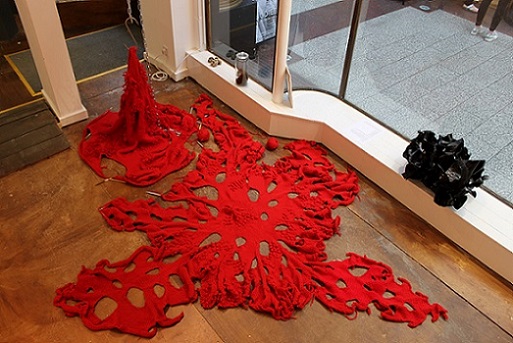
Heart of darkness, installed at Bodies at The Unit, Bristol, September 2017
Heart of darkness is my response to being diagnosed and living with a heart condition called supraventricular tachycardia (SVT) for three years. I am a compulsive swimmer, I swim outside most days. It’s another ‘state of flow’ activity; the rhythm and immersion induce that addictive sense of wellbeing, akin to knitting. Consequently, I was devastated when my first episode happened when I was swimming. That it was the same day as my first big assessment at University I’m sure is significant.
These episodes take the form of heart palpitations – an uncomfortable sensation at the best of times – racing heart, sweats, light headedness, faintness and nausea. It was scary! I was soon diagnosed with SVT, which, fortunately, isn’t life threatening, but is debilitating. It’s unpredictable and unpleasant. I was given tablets which would sometimes stop the palpitations, but would often have to go to A&E to have them stopped with an injection. Apparently it’s some kind of electrical fault, which can be triggered by exercise, caffeine, alcohol, illness and stress. The first few triggers can be monitored but stress is obviously harder to control.
So, I decided to knit my response. As I’ve already intimated elsewhere, knitting is a major stress reliever for me. When I begin to knit, I very quickly enter that seductive state of meditative timelessness, so it seemed like the obvious response. Knitting also acts as the back drop to my life; I knit whenever I can and wherever I am. It marks the passage of time. I started knitting it soon after the first episode. It isn’t a literal representation. I knitted it for me, as a kind of therapy. It represents the rhythm of my experiences….
Wearing one part of Heart of darkness at Privy, June 2016
It’s knitted from the centre out, firstly on double pointed needles, then on a circular needle as the knitting grows, and eventually on many circular needles, which I use in the same way as one would use double pointed needles. It means it can be any size, and is thrilling! I regard it as sculpture. It has its own intrinsic form, but is also very flexible so it can be sculpted into other forms using tension and gravity. It is made up of a series of interconnected irregular holes. Somehow the idea of knitting holes appeals to me. Hanging the knitted fabric suggests fragility and the holes bring an extra dimension of vulnerability to the piece. Faultiness. The surface is also textured in places, the ubiquitous bobble becomes something other in this context!
And why red? Louise Bourgeois wrote:
‘Red is the colour of blood.
Red is the colour of paint.
Red is the colour of violence.
Red is the colour of danger.
Red is the colour of shame.
Red is the colour of jealousy.
Red is the colour of grudges.
Red is the colour of blame.’
Bourgeois, Louise, 1998, in an interview with Cecilia Blomberg, in Bernadac, Marie- Laure, 2007, Louise Bourgeois, Flammarion: London
I think, for me, red is the colour of many things – fear, anger, (‘seeing red’), anxiety, mortality…. Knitting with just one colour also means that the form becomes more significant.
Heart of darkness
installed at Synecdoche's [dis]place at The Vestibules, Bristol, September 2017
And why a diptych? This begins as a practicality but it becomes conceptual the more often it happens. As I knit whenever and wherever I can, obviously when a piece reaches a certain size it’s no longer feasible for me to carry it around. I continue to knit it more privately, often at home. I will then start a new piece of work which becomes my ‘public knitting'. In this instance I didn’t consider the piece to be ‘finished’, so I began the second part of my Heart of darkness. Making two sculptures around this theme brings delightful flexibility in the ways it can be installed and also echoes the research I have done around multiple selves, particularly in the stitched Nobodies and Others series. Maybe if the SVT returns this will also become a multipart installation? The process of knitting becomes a narrative….
It has been exhibited in six different shows so far, with many permutations. Sometimes I have installed both pieces together, sometimes separately; it has been suspended from meat hooks and chains, draped, hung in a shop window and worn!For more about my thoughts on the versatility of knitting have a look at my Installation and site responsive works page and my blog post Art in unexpected places.
1. 2016 Privy; an exhibition of public and private stuff at The Edwardian Cloakroom, Bristol, June 22nd - 29th, Lou Baker with Nicola Pearce and Maura Zukina
2. 2016 Bodies: a group residency by Synecdoche Art Community, a month-long, socially engaged, site-responsive residency at The Unit, an empty shop in St James’ Arcade, Broadmead, Bristol, September 1st - 29th
3. 2016 Unravelling: an exhibition of knitting and crochet art, at Bow Arts’ Ice House Studios, London, October 6th - 16th
4. 2017 Window Wanderland at Room 212 Gallery, Bristol, February 4th - 21st
5. 2017 [dis]place at The Vestibules, Bristol, a month-long residency with Synecdoche, September 4th – October 2nd
6. 2017, PRILIC at Jacobs Wells Baths, Bristol, 8-16th December
Both parts of Heart of darkness (far left and far right)
exhibited with 9 of my other soft sculptures
at PRILIC, Jacobs Wells Baths, Bristol, December 2017
Watch this video to see one part of Heart of darkness moving spontaneously, to music, at PRILIC.
Heart of darkness is technically unfinished, but I haven’t continued knitting it for a long time. Fortunately, in June 2015, I had a successful oblation operation which seems to have fixed my heart, for now at least, but there’s still the possibility that it could recur. For me, the fact that it’s unfinished is significant; maybe if the SVT comes back I will take it up and start knitting it again?
2013, Nobody 3
I am a compulsive outdoor swimmer and I especially love being immersed in the sea so I set out to knit a large abstract wave. I have knitted a number of versions of the sea over the years and I return happily to this palette time and again. I often choose to knit the sea when I’m near the sea on holiday, so it also induces memories of relaxation and happy times.
Observing the sea in many conditions, for this piece I was especially interested in capturing the constantly varying textures of the sea, so I used different sculptural knitting techniques in ever increasing concentric circles in a range of blues. Naturally, I am unable to emulate the fleeting nature of those changes through knitting, but it has a pleasing aesthetic.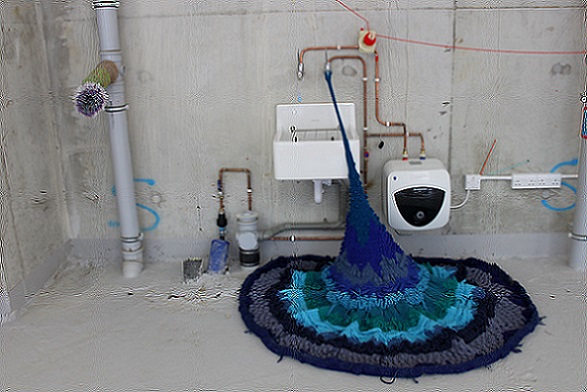
Nobody 3, installed at Unravelling: an exhibition of knitting and crochet art,
Bow Arts Ice House Studios, London, October 2016
I was working on this piece alongside my research into my Nobodies series. I was in the process of making the other two Nobodies, considering them as a diptych, but then realised that this knitted piece worked extremely well as Nobody 3. There’s something about the colour and its abject form when hanging that completes the triptych. It’s also a very similar size and shape and it fits well with the concept. Knitting for me is comforting, part of me and the wellbeing that creativity brings is a very important part of my practice. And so my wave began its life as a Nobody….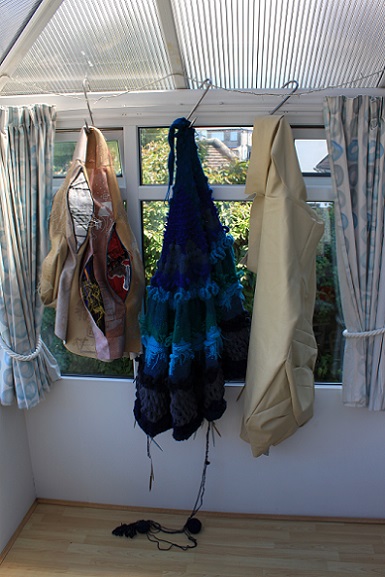
My knitted wave becomes a Nobody, May 2014!
I haven’t continued knitting it since then, although it is technically unfinished and still has two balls of wool attached to it. I like to leave much of my knitted work unfinished as it brings an added sense of vulnerability to it as it can potentially unravel….. and often it does! I find that it also makes many people uncomfortable; they feel an intense need to ‘rescue’ the unravelling stitches.
It also means I could carry on knitting….
I have installed it in a number of different situations, sometimes with the other Nobodies, but more often not. It was part of my Multitude installation at PRILIC in December 2017. Watch the video of it as part of a poignant dance response by Impermanence Dance Theatre.
I have worn it as well, of course, as part of my Wearing the unwearable series.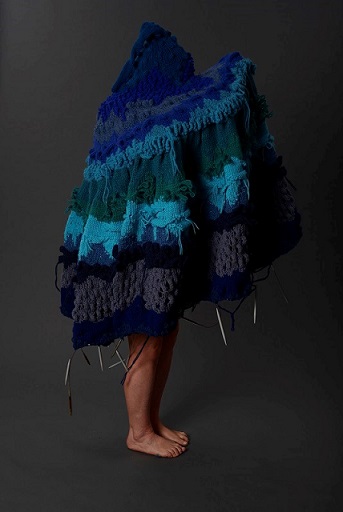
Me wearing Nobody 3 as part of my Wearing the unwearable performative series, July 2014
I have also had framed a fine art print of me wearing it which potentially means I can present it to a wider audience. This was exhibited at Synecdoche's Bodies exhibition at Southmead Hospital from March to July 2017 as part of the Fresh Arts programme.
For more about my thoughts on the versatility of knitting have a look at my Installation and site responsive works page and my blog post, Art in unexpected places
Have a look at my Stitch page too for more information and images about the Nobodies series.
Here’s a gallery with more images of Nobody 3:
1. Maura Zukina wearing the wave as a work in progress, October 2013
2. The wave in progress, draped, February 2014
3. The wave, detail
4. The wave, detail ( Photo by Jonny Baker)
5. Wearing the unwearable, May 2014
6. The wave becomes a Nobody, May 2014
7. Nobodies installed at Synecdoche, Embassy Tea Gallery, London, July 2014
8. Nobody 3, photoshoot, July 2014
9. Nobody 3, Wearing the unwearable, photoshoot, July 2014
10. Nobody 3 installed at Synecdoche’s exhibition at The Christmas Steps Gallery, Bristol, December 2014
11. Nobody 3 featured on the poster for Synecdoche at The Christmas Steps Gallery, November 2014 (Photo by Alex Davis, design by Rosie McLay)
12. Another image of Nobody 3 from the photoshoot outside The Christmas Steps Gallery, Bristol, November 2014
13.& 14. Nobody 3 installed at Unravelling: an exhibition of knitting and crochet art at Bow Arts Ice House Studios, London, October 2016
15. Framed fine art photographic print of Nobody 3, Wearing the unwearable, exhibited at Synecdoche’s Bodies exhibition at Southmead Hospital, Bristol as part of the Fresh Arts programme
16. -21. Nobody 3 featuring in Displacement activity # 2; mobile soft sculptures, part of my Displacement activity series at Synecdoche’s month long residency [dis]place at The Vestibules, Bristol, September 2017
22. Nobody 3 as part of Multitude, the installation of all my life sized soft sculptures at the PRILIC exhibition at Jacobs Wells Baths, Bristol, December 2017
2013, Shroud
Shroud is a hand-knitted reflection on a midlife crisis, an abstract self-portrait. Knitted in a spectrum of pinks, vibrant cerise fading to palest pink, it explores Carl Jung’s individuation, the process of finding meaning in life, which is ultimately a preparation for death. Jung talks about balancing our multiple selves with the dark side, or shadow, of ourselves, and maintains that failure to acknowledge and accept this shadow can result in fragmentation and associated mental health issues. He also describes the shadow as being the seat of creativity. 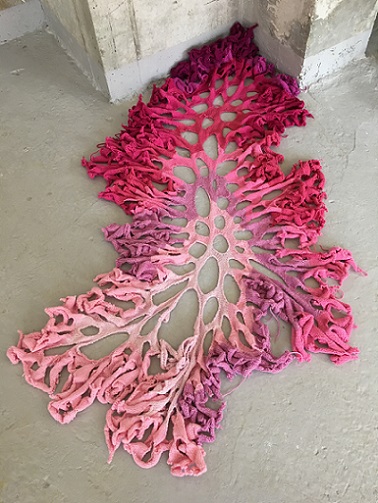
A trial installation of Shroud
at Unravelling: an exhibition of knitting and crochet art
at Bow Arts Ice House Studios, London, October 2016
Knitted as multiple holes, or absences, hints at fragmentation and that question of balance; its unfinished, undulating, unravelling edges, suggests a fragile, flesh-like bodily resonance. The form, title and concept challenge the stereotypical expectations of knitting and provide contrast with the seemingly benign, gendered colours and the comfort of hand-knitted wool. 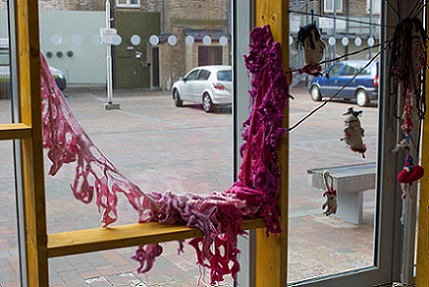
Final installation of Shroud at Unravelling, October 2016
Knitting a life-sized sculpture is labour-intensive, obsessive and oddly cathartic. In private, it becomes meditative, in public, it acts as a people-magnet, initiating interactions with strangers. I regard my knitting as a memory catcher, as thoughts, emotions and conversations are knitted into the fabric of the piece; its fragility underpins my investigations into the dialogue between personal memories and universal themes.
I have also made a stitched shroud, a brightly coloured crazy patchwork of my old clothes, velvet and zips. It’s called My imaginary friend. I’m hoping these 2 shrouds are not so much an obsession with death as a celebration of life. My family have been instructed to bury me in one!
My imaginary friend, 2010, used clothing, velvet, zips; stitch
For more about my thoughts on the versatility of knitting have a look at my Installation and site responsive works page and my blog post Art in unexpected places.
Here’s a gallery of images of Shroud:
1. Shroud, work in progress, 9th April 2013
2. Shroud, work in progress, 26th April 2013
3. Shroud, work in progress, 31st May 2013
4. Shroud, work in progress, 3rd June 2013
5. - 7. Shroud installed at Align’s Scratch exhibition at Centrespace Gallery, Bristol, June 2013
8. Alice Jennings wearing Shroud, 17.2.2015
9.&10. Trial installations at Unravelling: an exhibition of knitting and crochet art, Bow Arts Ice House Studio, London, October 2016
11. - 14. Shroud installed at Unravelling: an exhibition of knitting and crochet art, Bow Arts Ice House Studio, London, October 2016 (Photo 11 by Jonny Baker)
15. & 16. Shroud, detail (Photos by Jonny Baker)
17. Shroud, unravelling
18. Shroud, detail of installation at Unravelling: an exhibition of knitting and crochet art, Bow Arts Ice House Studio, London, October 2016
2012, Social network I and II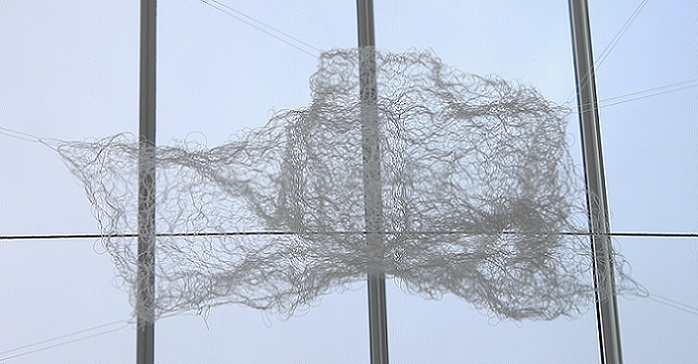
Social network I installed at Align exhibition at UWE, Bower Ashton Campus, Bristol, Nov 2012
Please click on the image for more details
2011, All the babies I might have had I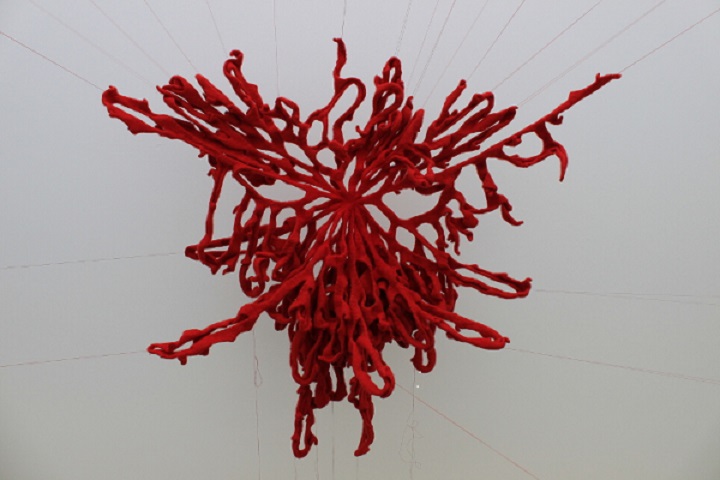
Please click the image for more details


